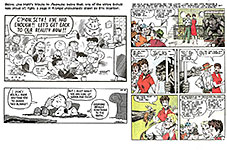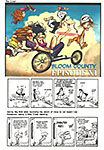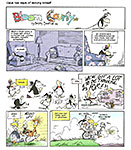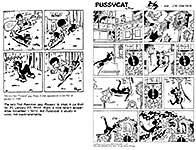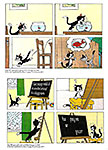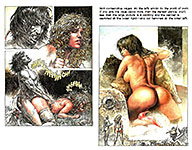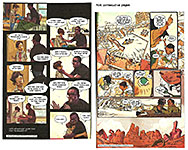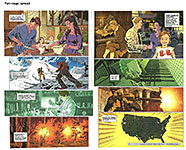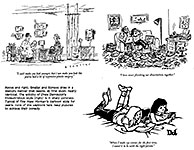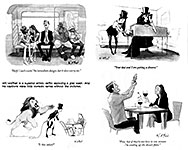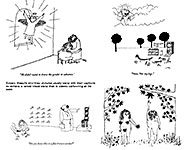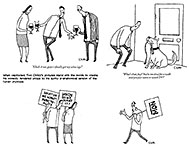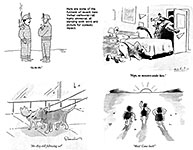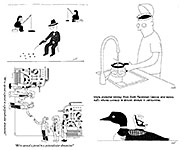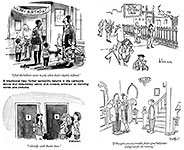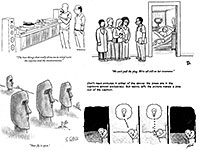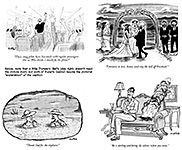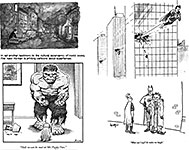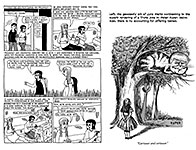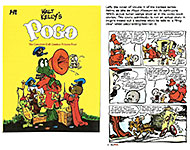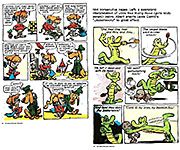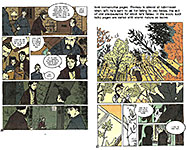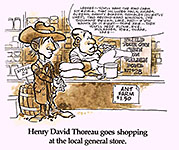 |
||||||||||||||||||||||||||||||||||||
Opus 362 (January 21, 2017). The plan, this month, was to finish and post this opus before the Inauguration. But, alas, as so oft happens here at Rancid Raves, our plan went, in Robert Burns’ phrase, agley. And so here we are scrambling to get into the digital ether on the weekend immediately after the Inauguration. The self-imposed delay matters not a whit, of course —except that now, after the Inauguration took place, we feel obliged to say something about it. And so we will, later on, down the scroll under the heading “The Vandals Have Arrived.” Here, we’ll react but briefly. The biggest news of the day is that the TrumpTwit changed his hair-do. He’s added what appears to be a part on the left side. This is a mistake. It reveals the essential comb-over character of the “do.” Sad. Veteran newsman Dan Rather, still wearing the mantle he inherited from Walter Cronkite as a trust-worthy journalist, reported his feelings after hearing the TrumpTwit’s speech: “Of the nearly 20 inaugurations I can remember, there has never been one that felt like today. Not even close. Never mind the question of the small size of the crowds [Obama’s estimated at 1.8 million; Trump’s, 700,000-900,000], or the boycott by dozens of lawmakers, or even the protest marches slated for tomorrow across the country [and taking place in D.C. even as Trump was speaking; over 200 arrested]. Those are plays upon the stage. What is truly unprecedented in my mind is the sheer magnitude of quickening heartbeats in millions of Americans, a majority of our country if the polls are to be believed, that face today buffeted within and without by the simmering ache of dread. I have never seen my country on an inauguration day so divided, so anxious, so fearful, so uncertain of its course.” We quote Rather’s remarks in full later on. For now, let us leave these grim reactions for the nonce and contemplate the happier events this opus celebrates. We review more than a dozen books (including the return of Bloom County via Facebook and the last Peanuts reprint from Fantagraphics plus the New Yorker Cartoons of 2016) and examine the reactions of scores of editoonists to the Trump transition and inauguration. We also report on Lynda Carter’s defense of Wonder Woman and the reason that DC has cancelled the second part of The Legend of Wonder Woman, and we briefly review Archie’s new title, Reggie and Me, and re-visit Christmas in the funnies and watch Will Eisner’s Spirit join Dick Tracy. And more—much more. It’s a yuuuge posting, kimo sabe, so we recommend that you peruse the detailed list of the contents below and choose what you want to dwell on, leaving the rest for another day (or never). To that purpose, then, here’s what’s here, in order, by department—:
Plastic Jesus (a poem)
NOUS R US Comics & Graphic Novels Selling Well Protest Comic Book for Women’s March Charlie Hebdo Soft on Islamic Hooliganism? More Watchmen to Watch Lynda Carter Defends Wonder Woman Thin-skinned DC Cancels Legend of Wonder Woman Obama’s Farewell Address
Odds & Addenda Deadpool Nominated for Best Screenplay Shakers Expiring “Fun Home” a “gem” Lucky Luke Gives Up—? Playboy Sales Brooke McEldowney Interview Coloring Books Fade New Superman Costume Taylor Swift
THE VANDALS HAVE ARRIVED TrumpTwit’s Inaugural Dan Rather’s Response ACLU’s Investigations Impeachment Proceedings
STREEP AND TWITTER TRUMPET Streep’s Speech in Full
FUNNYBOOK FAN FARE Comments on—: Dr. Strange Superwoman Motor Crush Red Sonja Reggie and Me
Editooning in the Age of Trumpery Editoonists’ Preferences for Presidential Satire Target Raw Thoughts About the Trumpet
EDITOONERY Some of the Best Editoons of the Last 60 Days
THE FROTH ESTATE Growth of Relationship between the News Media and the Right
NEWSPAPER COMICS PAGE VIGIL Christmas and Other Shenanigans in the Funnies Will Eisner’s Spirit Joins Dick Tracy
XMAS SHOPPING LIST Short Reviews of—: Complete Peanuts: Comics & Stories Ditko Monsters: Konga Bloom County on Face Book Peyo’s Pussycat Serpieri’s Anima Overstreet Comic Book Price Guide, No.46 Love Is Love (Benefit Anthology for Orlando)
BOOK REVIEWS Longer Reviews of—: New Yorker Cartoons of 2016 (Generously Sampled) The Comic Art of War: A Critical Study Walt Kelly’s Pogo: The Complete Dell Comics, Volume Four Panel to Screen: Comic Books and Film The Meaning of Superhero Comic Books
LONG FORM PAGINATED CARTOON STRIPS (Er, “graphic novels”) Thoreau: A Sublime Life
ONWARD, THE SPREADING PUNDITRY More Political Commentary by Yr Reporter
PASSIN’ THROUGH Mad’s Don “Duck” Edwing
QUOTE OF THE MONTH If Not of A Lifetime “Goddamn it, you’ve got to be kind.”—Kurt Vonnegut
Our Motto: It takes all kinds. Live and let live. Wear glasses if you need ’em. But it’s hard to live by this axiom in the Age of Tea Baggers, so we’ve added another motto:. Seven days without comics makes one weak. (You can’t have too many mottos.)
And our customary reminder: don’t forget to activate the “Bathroom Button” by clicking on the “print friendly version” so you can print off a copy of just this installment for reading later, at your leisure while enthroned. Without further adieu, then, here we go—:
Plastic Jesus Billy Idol
I don't care if
it Ridin' on the
dashboard Through my
trials With my plastic
Jesus
When I'm in a
traffic jam 'Cause Jesus'
plastic doesn't hear The man who invented
plastic
And if I weave
around at night 'Cause plastic Jesus shelters me For his head
comes off you see Whoa Whoa Whoa
Songwriters: Ed Rush, George Cromarty
After hearing the first verse, I couldn’t resist. Now let’s get serious—:
NOUS R US Some of All the News That Gives Us Fits
COMICS AND GRAPHIC NOVELS DO WELL IN 2016 Last year, reports Michael Cavna, the only area within adult fiction that increased in sales over 2015 was graphic novels. He quotes Publishers Weekly, which, citing Nielsen BookScan numbers, asserts: “The lone bright spot in fiction was comics and graphic novels, which had a 12% increase on the year.” Fiction overall was nearly flat last year, dipping by 1 percent. There were “no breakout bestsellers” in adult fiction, PW reports, and almost “all fiction subcategories closed out the year lower than in 2015.” Yet amid this nearly across-the-board decline on the fiction side, comics were too popular to be denied.
PROTEST COMIC BOOK FOR THE WOMEN’S MARCH In the wake of the Trump triumph (to be termed Trumph hereafter), more than a few disgruntled and alarmed artists and cartoonists have created a radical feminist comic book of illustrations that focus “on the theme of political resistance to the forces of intolerance.” Entitled RESIST!, the comic book is a result of a collaboration between the art director of The New Yorker, Françoise Mouly, her daughter Nadja Spiegelman, and Gabe Fowler, the publisher of a quarterly comic book anthology called Smoke Signal, who offered a special free 40-page edition of his tabloid paper to be released at the time of the Inauguration and a “women’s march,” scheduled for January 21, the day after the Trumpet takes office. When Mouly heard that the TrumpTwit had been elected president, she says, “I was in a state of shock.” The cover image she’d been planning for the week’s issue of The New Yorker — which played on the theme of the first woman president — had to be scrapped. Instead, for the magazine’s November 11 issue, she chose an image of a brick wall stacked almost to the top of the page [see Opus 361]. And then, like so many Americans trying to adjust to their new reality, she had to figure out what to do next. At this point, her daughter got involved. “There was a need to be making something rather than sitting around feeling helpless,” Spiegelman told NY Mag, quoted by Toni Airaksinen at redalertpolitics.com. “And this felt like a way of giving voice to something that needed to exist.” Just after Thanksgiving, Spiegelman and Mouly posted a call for submissions on Facebook, and within hours, thousands responded. At first, most of the contributions came from men, but by December 10, Mouly told Betsy Gomez at CBLDF, there were more women than men: “We were getting many comics by women on the topic of resisting the force of fascism.” Among their messages: “Build a Wall Around Trump” by Julie Wilson, an artist living in Santa Monica, “We Shall Overcomb Trump” by artist Kristina Lee, and “We Are Going to Mars, the World is Too Scary for Us” by Ozge Samanci, a professor at Northwestern University. Some of the contributors are well-known cartoonists—Alison Bechdel, Lynda Barry, Emil Ferris—but “we have work by people who aren’t professional cartoonists,” Spiegelman said. “RESIST! revives the tradition of using comics for protest,” she added.
The tabloid features the work of over 120 artists, Mouly told Gomez—“somewhere around a hundred women, and also a section in the back, the ‘man cave,’ and inbetween a page called ‘Gender Is Not Binary.’ “Surprisingly,” she added, “nobody sent us anything that was in praise of Donald Trump.” [Not so surprising, considering the nature of the call.—RCH] Mouly said she and her daughter undertook the task at first just to address their own need to do something. But they soon achieved other objectives: they realized there was an absolute force “out there.” “We want them to be as aware as we are of the positive or the constructive force,” Mouly told Gomez. “It’s not an attack on Donald Trump. It’s a celebration of everything that we have in common, of not just women, but men also and people for whom gender is fluid. ... Everyone who feels that they lost something on November 8th—they should be able to find something here that is at least as sustaining as what was taken away that day.” Added Spiegelman: “One thing that was so moving when going through the submissions was the sense—because we were sorting them by gender—we began to get such a sense of what a female voice is as distinct from a male voice. ... when you see that the empathy, funniness, vulgarity, the women drawing uteruses but also drawing their mothers and daughters and grandmothers, and drawing women linked arm in arm and drawing how they felt the day after and drawing emotions and also their anger—that sense of the collective female voice is something that is so powerful. ... I think that—I hope that people just can hear that. That’s what I hope.” Over 55,000 of the tabloid have been printed, and they’re being distributed on pallets of 5,000 to regional distributors for dissemination throughout the country, especially during sympathetic “women’s marches” held in other cities. While the March was not initially planned to be an anti-Trump protest, after the results of the election, it seems the event has taken a little bit of a turn. Anti-Trump protesters are planning on attending, and Planned Parenthood has since become an official partner of the event. The print run is woefully short of meeting what may be presumed to be the demand. The “women’s march” reportedly took place in nearly 700 cities in the U.S. and worldwide, “a roaring rejoinder to the inauguration of Trump, an unprecedented international rebuke of the new president,” said the Washington Post article. And in all of those sites I’ve heard about, the number of participants exceeded expectations. In Denver, where 40,000 were expected, an estimated 100,000 showed up. In Washington, porta-potties weren’t up to the job. After they were rendered useless, people were given cups and told to use them in a box truck that had been designated for privacy. “I was afraid to shake anyone’s hand,” said one woman, laughing.
HAS CHARLIE GONE SOFT ON ISLAMIC HOOLIGANISM? One of Charlie Hebdo’s most outspoken journalists quit the satirical magazine at the end of December because, she says, it has gone soft on Islamist extremism. AFP reports that “Zineb El Rhazoui accused the weekly of bowing to Islamist extremists and no longer daring to draw the Prophet Muhammad.” Said she in a damning interview with AFP: “Charlie Hebdo died on January 7” 2015, the day the gunmen attacked the magazine, killing 12 people. She said she felt Charlie Hebdo now follows the editorial line the extremists had demanded “before the attack — that Muhammad is no longer depicted.” El Rhazoui, 35, who is followed everywhere by police bodyguards and is known as the most protected woman in France, also questioned the magazine’s “capacity to carry the torch of irreverence and absolute liberty.”
MORE WATCHMEN TO WATCH? DC Comics just can’t let well enough alone. After one mediocre attempt to expand the Watchmen universe by producing a “prequel” series about what Alan Moore’s superheroes did before the publication of the initial Watchmen, DC is apparently poised to try another approach to milking Moore’s seminal creation for all it’s worth. Apparently, saith Abraham Riesman at vulture.com, in this new incarnation, the Watchmen will cross-over to meet the superheroes of DC’s universe—Superman, Batman, Wonder Woman et al. It’s a project that could go very, very wrong, Riesman said. “Notice the lack of a ‘the’ in Moore’s title as it’s the key to understanding the potential disaster the story might turn out to be.” At first glance, Riesman goes on, we may suppose that Moore’s book is about a team of superheroes called “the Watchmen.” But that team never shows up. “There is no group by that name,” Riesman says. “The noun, as it turns out, is referring to Juvenal’s immortal question, ‘Quis custodiet ipsos custodes,’ one translation of which is, ‘Who watches the watchmen?’ “It’s a clever and disarming misdirect: instead of denoting the costumed crusaders in the novel, the title is critiquing them for their narcissistic decision to act as humanity’s unaccountable guardians — and critiquing us for our dreams about letting them do so. That’s sorta the whole point of Watchmen. Three decades after it debuted, it remains the gold standard for deconstructionist superhero stories, subverting the perverted power fantasies and harmful delusions of grandeur that we indulge in when we create or consume superhero fiction.” DC is likely to miss that point, Riesman speculates, “treating the pointedly pathetic protagonists of Watchmen as just another super-team. In fact, it seems almost inevitable.” And it will undercut and destroy the whole idea of Moore’s Watchmen, Riesman continues: “Moore ... [made] an epic that was free of the moralism and heroism of the mainstream DC universe. In the ecosystem of conventional superhero stories, the good guys always win, the bad guys always lose, and the moral gray areas are never thatgray. That kind of approach is antithetical to the themes of Watchmen, in which the good guys are fuck-ups, sadists, and/or sociopaths whose personal failings wind up making them the bad guys. What’s more, their world mostly follows the laws and logic of our own, with only one character possessing actual superpowers — a fact that makes him horrifyingly pivotal in the fate of humanity.” So what will happen when the “earnest do-gooders” of the DC universe meet “the tragic idiots? There are only two possibilities that I can imagine,” Riesman writes. “One is an extremely metatextual satire that finds humor in the eye-rolling notion of such an encounter. But that’s about as likely as Batman adding a tutu to his costume. Much more probable is a story that crassly capitalizes on 30 years of enthusiasm for and familiarity with Watchmen’s characters by throwing them into a serious, high-octane adventure alongside the kinds of figures they were designed to mock. The idea is perverse in its misguided, more-is-more shallowness.” Riesman says he “struggles” to imagine “what anyone could do to make a worthwhile and respectful Watchmen tie-in. We should withhold critical judgment until the pudding is made, but I’m not holding out a lot of hope.” Riesman mentions DC’s recently launched Rebirth in which “creators were told to tweak the venerable mainstream-superhero pantheon so the characters could be their best selves.” It’s possible, I suppose, that “the” Watchmen could serve as a thematic foil, contrasting failed or flawed superheroism with successful “best selves” superheroism in the Rebirthed DC universe. Such a maneuver would give the Watchmen a serious (if not satirical) function. It would also perpetuate Moore’s theme. That, however, is not likely to happen. DC is almost certainly simply using the fame of Moore’s Watchmen to hype sales of its titles, a sad but capitalistically sound tradition.
LYNDA CARTER DEFENDS WONDER WOMAN As we reported last time (Opus 361), after just two months, Wonder Woman lost her gig at the United Nations as a symbol of self-empowerment for girls and women. Too many observers thought she was more pin-up than feminist icon and therefore not a suitable symbol at the U.N. Alex Williams reported at nytimes.com that “a United Nations spokesman said the campaign had merely run its course, and that the end had nothing to do with the uproar” that ensued when Wonder Woman was first announced as an ambassador for women and girls and for gender equality But “one loyalist was not going to sit by as her cape was dragged through the mud: Lynda Carter, the actress who starred in the 1970s television show “Wonder Woman,” came to the Amazon’s defense. Now 65, Carter took time from acting (including a role as the U.S. President on “Supergirl” and a governor in the coming film “Super Troopers 2”) and career as a singer (she just competed a four-city tour and is recording her third studio album) to discuss the complex legacy of her Amazon princess alter ego. In an edited and condensed interview with Williams, Carter recognized at the onset the disagreement about what a feminist icon should look like: “What I find interesting is that they didn’t look at the larger picture. I agree that the issue of gender equality is much larger than any character is, and I understand that a comic book character should not be representative of something that is that important. I agree with that. What I disagree with is this [mistaken] idea about Wonder Woman. She’s an iconic defender. She’s archetypal. It’s the ultimate sexist thing to say that’s all you can see, when you think about Wonder Woman, all you can think about is a sex object.” About Wonder Woman’s skimpy costume, Carter was a little belligerent: “Yeah, so?” she said. “Superman had a skintight outfit that showed every little ripple, didn’t he? Doesn’t he have a great big bulge in his crotch? Hello! So why don’t they complain about that? And who says Wonder Woman is ‘white’? I’m half-Mexican. Gal Gadot is Israeli. The character is an Amazonian princess, not ‘American.’ They’re trying to put her in a box, and she’s not in a box.” (Er, I don’t see the super bulge that Carter sees at Superman’s crotch. Could she be imagining things? Things she wishes for?) About her own stint in the star-spangled scanties: “If you think of the ’70s, that was miniskirts and bikinis. I never really thought of Wonder Woman as a super-racy character. She wasn’t out there being predatory. She was saying: ‘You have a problem with a strong woman? I am who I am, get over it.’ I never played her as mousy. I played her being for women, not against men. For fair play and fair pay.” Why did “Wonder Woman” on tv “strike a chord with girls watching the show”? “There was this idea that inside every woman is a secret self. It’s much less about the color of your skin, much less about your height or weight or beauty, but it’s the attitude, the strength of character, the fight for rights— the beauty within, the wisdom within.” Carter attributes her post-Wonder Woman struggles with alcohol to her bad marriage not post-fame blues. Drinking brought solace at the time, she said, “but now it’s coming up on 20 years since I’ve been sober.” Asked about her inspiration for the presidential role she assumed in “Supergirl,” Carter said: “It was Hillary. I’ve known Hillary Clinton for 35 years. She is the kindest, most wonderful human being. She has an infectious personality and smile and warmth and personality and true nature. She grew up in a time where you had a be a certain way to be taken seriously. Now you can be whoever you want. You don’t have to be serious. You can be feminine and powerful at the same time.”
MORE TROUBLE FOR WONDER WOMAN Institutionally, turns out that DC Comics has a thin skin and a feudal attitude. The company cancelled its critically acclaimed, Eisner-nominated comic book series The Legend of Wonder Woman because its creators made critical remarks on social media about other creative teams on DC books. A spokesperson for DC said the series, which had been slated for a second part, was ended because of “a challenging relationship” with the husband and wife creative team, artist Ray Dillon and writer Renae De Liz, who had created nine issues of The Legend, telling the story of the Amazonian from her origins on the planet Themyscira to arriving on Earth to become a superhero. A digital-first series, a collected edition was released in hardback on 13 December. Sian Cain at the Guardian reported that the DC spokesperson said “we loved the book and we were very excited to work on the collected volume,” but DC was concerned about Dillon’s public comments on social media about other teams at DC. Wrote Cain: “In a series of now-deleted tweets, preserved online on Bleeding Cool, Dillon criticised the writing in another DC series, Wonder Woman: Earth One, and complained when DC approved future volumes of Earth One while he was waiting to hear about the future of his own series. On hearing the news that Kevin Grevioux had been confirmed to write a series about the Amazonians, titled The Odyssey of the Amazons, Dillon alleged that he and De Liz had already pitched a similar idea to DC but had never heard back about it. De Liz also complained, tweeting that while she was happy the series would happen, she “felt I could have added a lot as a female creator.” “It is an unfortunate situation. We tried hard to make it work,” the DC spokesperson said. [Probably not very hard.—RCH.] Dillon told Cain: “I wish no negativity on anyone, and support DC and the people who work there 100%. I’m just looking forward to getting through the hurdle of sudden loss of finances during a crucial time and moving forward to an exciting, productive new year.” The “crucial time” referred to De Liz’s fourth pregnancy, which is apparently threatened. Dillon said that he and his wife were now focusing on their creation, the superhero Lady Powerpunch. DC has historically been sensitive to public criticism from their creators, Cain said. “In 2009, Justice League of America writer Dwayne McDuffie was fired after making comments on a DC Comics discussion board about his frustrations with the project, while Fairest writer Chris Roberson was told specifically that he had lost his role on the DC title for ‘one tweet which questioned the ethics of the company.’” When the cancellation was announced on Thursday, December 15, De Liz took to Twitter to say she was “surprised and devastated” the series had been cancelled. She also revealed that she is pregnant with her fourth child, tweeting that the announcement had fallen at a difficult time of year, just before Christmas. “I am very grateful to DC for the opportunity to work with such an iconic character over the last few years, that was a joy like none other.” Rich Johnston at bleedingcool.com reports De Liz’s Facebook posting (in italics)—: There’s seems to be a ton of articles on LoWW at the moment, and wild ideas of what happened, and misconceptions of who we are, so let me say a couple things to clarify so we (and DC) can hopefully move on from this. DC stated “challenging relationship”as the cause for the end of LOWW, which I feel is fair from both sides. I want LoWW readers to know, never once did I knowingly cross any lines, or feel that I risked LoWW in any way, which is why I was SO shocked by the turn of events. I am a very careful person, and would never have risked it. My true mistake was not recognizing the atmosphere of my work environment (perhaps a hazard of working remotely) so I could understand the expectations from it. I had the impression everything was fine & was told repeatedly I was welcome to share my concerns or opinions anytime, so I trusted it was wanted, and safe to give them privately and respectfully. If I had known my thoughts were not appreciated, I would not have given them. My couple tweets seen in most articles were relating feelings and not intended as a negative towards DC. I didn’t recognize it was viewed so harshly, or was forbidden, and I apologize for any harm they did. In the last week I’ve lost a dream project, been uplifted by the comics community, been accused of being horrible things, while dealing with a threatened pregnancy. We are not bad people, we didn’t know we were…er…”poo-ing” where we ate and weren’t roving around DC like a couple ungrateful, mindless rebels. We just missed information somewhere which led to us choosing honesty instead of the expected compliance. So I hope now news sites will give my family peace through the Holidays, because we sorely need it, especially for baby soon-to-be. There is no ill will to DC, and no crazy story to tell. It’s just the way things worked out this time. I will be forever grateful for my time with Wonder Woman, and to the readers who supported it. I’ll always be right here, continuing to support the works of DC’s wonderful creators, and I hope everyone does the same.
Okay: she’d like her job back so she’s speaking very soothingly about DC. We’ll see. After being encouraged by fans on Twitter, De Liz set up a GoFundMe page to accept donations for her family. It has already raised more than $5,000 (£4,000) at time of writing (December 20), exceeding its initial $2,000 goal in less than 24 hours. Johnston reports that 475 people have signed a petition to return The Legend Of Wonder Woman to publication, including Wonder Woman ongoing series writer Greg Rucka. In an update, De Liz thanked supporters and said the money would not only help her family at Christmas, but also gave her and Dillon more creative freedom. “No matter what we do, I’ll always be pushing for creating adventures for all ages that are uplifting, fun, and full of examples of diverse, strong characters, especially for young girls to look up to, and show them that they too are capable of doing anything,” she wrote.
OBAMA’S FAREWELL ADDRESS January 10, 2017; McCormick Place, Chicago Some called it a lament. But they were wrong. It was a victory speech, a ringing declaration of victory. Obama summarized some of the achievements of his administration—and some of his frustration at having to work with a thoroughly reprehensible Grandstanding Obstructionist Pachyderm that sought to prevent him from accomplishing anything. But mostly, he talked about his vision of America and the obligations of citizenship, of working out of hope for the future not fear. His optimism about the country is greater now than it was four years ago, he said. In other words, the GOP was unable to shut him down. He survived. And his optimism survived. “Yes, we can,” he said triumphantly. “Yes, we can. Yes, we can.” Yes, we can.
ODDS & ADDENDA The December
issue of the Previews catalog contained a picture of the new Wonder
Woman statuette, “Gotham City Garage,” showing the star spangled Amazon
leaning up against her ride, a glitzy hog. Now look closely at the accompanying
illustration: does she have tattoos on her forearms? ■ When Sister Frances Carr died at 89 earlier this month, the nearly extinct religious society called the Shakers was down to only two members. Saith the Associated Press: “The Shakers’ numbers declined because members are celibate and the group stopped taking orphans as new members.” Well, duh. Celibacy is not a way of life. ■ “Fun Home,” the musical based upon Alison Bechdel’s graphic novel, is now running in Denver, and the Denver Post’s drama critic, Joanne Ostrow, calls it “a concise gem—joyful and melancholy, a story of memory and family, ‘Fun Home’ is a rare beauty of a musical.” ■
In the immediate vicinity, you’ll see a familiar picture that appears without
variation on the back of all Lucky Luke books—the comically dramatic
portrait of a Western gunslinger so fast that he beats his own shadow to the
draw. ■ According to Harper’s Index, newsstand sales of Playboy since its conversion to no-nipples nudity have increased by 28%; subscriptions, on the other hand, have dropped by 23%. Translation: people are no longer fearful of being seen buying the magazine in public, and without barenekkidwimmin, there’s no need to acquire Playboy almost anonymously by the surreptitious means of getting it mailed to you. ■ We’re big fans of Brooke McEldowney’s syndicated comic strip 9 Chickweed Lane, and he also produces an online strip, Pibgorn, about a fairy, a fanciful triumph (both available online at GoComics.com). McEldowney, who delves into romance and sex more deeply (and deftly) and feelingly than any other syndicated comic strip, also plays with the form itself, as we can see at the bottom of the visual aid just posted. McEldowney is interviewed by Michelle Tompkins at http://thecelebritycafe.com/2017/01/interview-9-chickweed-lanepibgorn-comics-creator-brooke-mceldowney/ —worth a look. Literate and funny, like both of McEldowney’s strips. McEldowney has been systematically anthologizing Chickweed Lane from the beginning. So far, the archival effort is up to 14 books, all available at pibpress.blogspot.com. All recommended. (But you knew I’d say that, eh?) ■ Those coloring books for grown-ups that went so well in bookstores during the 2015 Xmas season didn’t rescue brick-and-morter operations this year. Barnes & Noble reported a severe downturn in coloring book sales, leading to the company’s first decline in holiday sales in three years according to Bloomberg News. ■ DC Comics is unveiling a “new” Superman costume. It’s like the “old” one except the red underwear worn on the outside is gone; and the red boots are back. ■ The thing I don’t like about Taylor Swift is that she looks like a chipmunk. A chipmunk with lipstick, but a chipmunk still. People ought not to look like chipmunks.
THE VANDALS HAVE ARRIVED The “vandals” in traditional Western history were a mob of barbarians who sacked and looted Rome in about 455 A.D. LISTENING TO THE TRUMPET blow his horn after taking the oath of office, I was comforted in a vaguely unsettling way to know that he has not changed his tune in the slightest. At least he’s consistent, providing us thereby ammunition for future use. After losing the election in a mudslide, he showed up to deliver his long-awaited Inaugural Address. Superfluous. It was more of the same. It was short—doubtless because the TrumpTwit cannot sustain even a one-sided conversation for very long. In content, it was all of his campaign slogans all over again, this time transformed into complete sentences. Sad. He repeated to a frightening extent his “America First” doctrine. On the one hand, he undoubtedly alarmed other nations with his ego-centric pronouncement. On the other, American foreign policy has always been “America First”: everything we have done abroad (even the altruistic-seeming Marshall Plan to restore Europe after World War II) has been, ultimately, for the benefit of the American people—their security, the economy. So that was nothing new. It was merely phrased in the baldest, most objectionable way possible. And his depiction of America as a wasteland of drug addicts, crime, violence, joblessness, and poverty was grossly wrong. How could such a society function? It couldn’t. Yet ours does. Clearly, the TrumpTwit was wrong wrong wrong. He was simply lying lying lying. This pussy-groping self-aggrandizing blowhard blusterer with rampant insecurities and a perpetual pout is clearly wrong for the job. And yet, he has it. He didn’t mention the nefarious Wall he wants to build along our southern border. Nor did he mention Obamacare. (But among his first official acts was to sign an executive order giving federal agencies broad powers to unwind regulations created by the ACA, to delay or to grant waivers and exemptions to provisions of the law. Geez: and all this time, I thought the Executive Branch of government executed the law while the Legislative Branch made the laws. Not under Trump. Still, it’s unclear what impact, if any, the executive order will have. Practically speaking, it’s mostly symbollic of the Trumpet’s higher intentions.) He offered the merest glimmer of hope, vowing to let the American people govern themselves instead of leaving government to the bloated windbags and unscrupulous thieves that presently occupy Washington and render it dysfunctional while lining their own pockets (with re-election campaign money only, of course). But even as he spoke, his minions took down those portions of the White House website having to do with climate change, replacing it with an “America First” energy policy that effectively repeals Bonco Bama’s Climate Action Plan and clean air and water protections. Also removed are the pages on civil rights, LGBT and healthcare. Other adjustments are less cosmetic. The National Endowment for the Arts and National Endowment for the Humanities will be eliminated entirely—if the TrumpTwit gets his way. And the Corporation for Public Broadcasting would be privatized. Noisy achievements but, if the Trumpkins are really planning to cut the budget, not counting for much: they account for only 0.02 percent of spending. Philip Bump at the Washington Post explained: “If you make $50,000 a year, spending the equivalent of what the government spends on these three programs would be liek spending less than $10.” But the Trumpet will get credit for massive fiscal prudence. Stephen King’s assessment of the day is short and to the point: “Welcome to the age of plunder, bluster, and empty rhetoric. In other words, to the Age of Dumb.” Democrats of course criticized the speech. “It was surprisingly dark to me, said Michigan Senator Debbie Stabenow. “Not very hopeful or inspirational. I see a lot of hopefulness in our cities and hopefulness among our people, and he described a very dire picture of American that I don’t share.” Few do. Conservative columnist George Will called the speech “the most dreadful inaugural address in history.” Dan Rather went on at greater length, also accurately, to wit (in italics)—: And so it begins. Of the nearly 20 inaugurations I can remember, there has never been one that felt like today. Not even close. Never mind the question of the small size of the crowds, or the boycott by dozens of lawmakers, or even the protest marches slated for tomorrow across the country. Those are plays upon the stage. What is truly unprecedented in my mind is the sheer magnitude of quickening heartbeats in millions of Americans, a majority of our country if the polls are to be believed, that face today buffeted within and without by the simmering ache of dread. I have never seen my country on an inauguration day so divided, so anxious, so fearful, so uncertain of its course. I have never seen a transition so divisive with cabinet picks so encumbered by serious questions of qualifications and ethics. I have never seen the specter of a foreign foe cast such a dark shadow over the workings of our democracy. I have never seen an incoming president so preoccupied with responding to the understandable vagaries of dissent and seemingly unwilling to contend with the full weight and responsibilities of the most powerful job in the world. I have never seen such a tangled web of conflicting interests. Despite the pageantry of unity on display at the Capitol today, there is a piercing sense that we are entering a chapter in our nation's evolving story unlike one ever yet written. To be sure, there are millions of Donald Trump supporters who are euphoric with their candidate's rise. Other Trump voters have expressed reservations, having preferred his bluster to his rival's perceived shortcomings in the last election, but admitting more and more that they are not sure what kind of man they bestowed the keys to the presidency. The rest of America— the majority of voters— would not be— and indeed is not— hesitant in sharing its conclusions on the character and fitness of Donald Trump for the office he now holds. The hope one hears from even some of Donald Trump's critics is that this moment might change him. Perhaps, as he stood there on a grey, drab, January day, reciting the solemn oath of office demanded by our Constitution, as he looked out across what Charles Dickens once called the "city of magnificent intentions,” he would somehow grasp the importance of what he was undertaking. Perhaps he would understand that he must be the president of all the United States, in action as well as in word. Perhaps, but there has already been so much past that is prologue. There is usually much fanfare around inaugural addresses. They are also usually forgotten— with some notable exceptions. I think today will be remembered, not so much for the rhetoric or the turns of phrase but for the man who delivered them and the era they usher us forth. Mr. Trump's delivery was staccato and there was very little eye contact as he seemed to be reading carefully from a teleprompter. His words and tone were angry and defiant. He is still in campaign mode and nary a whiff of a unifying spirit. There was little or nothing of uplift—the rhetoric of Washington, Lincoln, Roosevelt, Kennedy, or Reagan. We heard a cavalcade of slogans and one liners, of huge promises to "bring back" an America— whatever that really means to many who look at our history and see progress in our current society. The speech started with a message of an establishment in Washington earning riches on the back of struggling families across the country. It was an odd note, considering the background of many of his cabinet picks. President Trump painted a very dark picture of the current state of our nation, beset by gangs and drugs and violence, regardless of what the data shows. His words swelled with his economic populism and the nationalism of "America first." The applause was sparse, and I imagine many more being turned off, even sickened, rather than inspired by what our new President had to say. President Obama looked on with an opaque poker face. One could only imagine what he was thinking. It bears remembering that one never can predict the arc of a presidency. It is an office that is far too often shaped by circumstance well beyond its occupant's control. Those challenges, wherever and however they may rise, now will fall on the desk of President Trump. We can only see what will happen. We hope, for the security and sanctity of our Republic, that Mr. Trump will respond to the challenges with circumspection and wisdom. Today's rhetoric was not reassuring. Our democracy demands debate and dissent—fierce, sustained, and unflinching when necessary. I sense that tide is rising amongst an opposition eager to toss aside passivity for action. We are already seeing a more emboldened Democratic party than I have witnessed in ages. It is being fueled by a fervent energy bubbling from the grassroots up, rather than the top down. These are the swirling currents about our ship of state. We now have a new and untested captain. His power is immense, but it is not bestowed from a divinity on high. It is derived, as the saying goes, from the consent of the governed. That means President Trump now works for us - all of us. And if he forgets that, it will be our duty to remind him.
AMONG THOSE WHO ARE ALREADY SET on reminding the TrumpTwit is the American Civil Liberties Union, which started the day before Trump took the oath. “According to our analysis,” reads the ACLU statement at aclu.org, “then-candidate Trump articulated policies that would flagrantly violate the First, Fourth, Fifth, Eighth and 14th Amendments to the U.S. Constitution. ... We believe the Trump administration poses the single greatest threat to civil liberties, civil rights, and the rule of law in modern memory. ... We have the strategy and some of the resources needed to challenge the Trump administration’s policies and protect the Constitution.” Vowing to become the David to oppose the federal government’s Goliath, ACLU went on: “The first rock in our slingshot is a Freedom of Information Act request asking several government agencies to turn over documents relating to President Trump’s actual or lpotential conflicts of interest due to his business and family connections. The American people deserve to know their president will govern in the best interest of the nation and not his self-interest.” In a Time magazine report, ACLU’s executive director Anthony Romero said: “We are bringing this first legal action using the Freedom of Information Act to underscore the fact that President Trump is not above the law. Freedom of Information requests are our democracy’s X-ray, and they will be vitally important to expose and curb the abuses of a president who believes the rules don’t apply to him and his family.” The ACLU statement announced the rest of its Seven-Point plan “to fight back against the Trump administration when it seeks to violate the rights and liberties granted by the Constitution.” In addition to demanding government accountability and transparency, the plan aims to protect the rights of immigrants, demands reproductive rights, protects First Amendment rights, defends LGBT rights, defends core civil rights and civil liberties from erosion, and mobilizes the American people. Details at aclu.org. And then when the Trumpet saw photographs that compared the size of the crowds at his and Obama’s inaugurations to his disadvantage, he ordered the Park Service to withdrawn the photos. Elsewhere, a campaign to impeach the new Prez is gathering steam, hinging its case on Trump’s insistence on maintaining ownership of his luxury hotel and golf course business while in office. Adding fuel to the burgeoning blaze are other conflict of interest aspects of the new White House website that remind visitors that Trump’s book, The Art of the Deal, is still in print and for sale and that First Lady Melania Trump’s jewelry line is for sale on cable tv channel QVC. The
reaction of the nation’s editoonists is to some extent predictable: most of
them are of liberal persuasion.
Fascinating Footnit. Much of the news retailed in the foregoing segment is culled from articles eventually indexed at rpi.edu/~bulloj/comxbib.html, the Comics Research Bibliography, maintained by Michael Rhode and John Bullough, which covers comic books, comic strips, animation, caricature, cartoons, bandes dessinees and related topics. It also provides links to numerous other sites that delve deeply into cartooning topics. For even more comics news, consult these four other sites: Mark Evanier’s povonline.com, Alan Gardner’s DailyCartoonist.com, Tom Spurgeon’s comicsreporter.com, and Michael Cavna at voices.washingtonpost.com./comic-riffs . For delving into the history of our beloved medium, you can’t go wrong by visiting Allan Holtz’s strippersguide.blogspot.com, where Allan regularly posts rare findings from his forays into the vast reaches of newspaper microfilm files hither and yon.
FURTHER ADO The common swift can stay in the air without landing for ten months, according to findings reported in Current Biology. “It’s obvious that women are smarter than men. Think about it: diamonds are a girl’s best friend, but man’s best friend is a dog.”—Joan Rivers
STREEP AND TWITTER TRUMPET Here’s Merle Streep at the 74th Golden Globe Awards with her now celebrated acceptance speech upon receiving the DeMille Lifetime Achievement Award—: Thank you. I love you all. You'll have to forgive me. I've lost my voice in screaming and lamentation this weekend. And I have lost my mind sometime earlier this year, so I have to read. Thank you, Hollywood Foreign Press. Just to pick up on what Hugh Laurie said, you and all of us in this room, really, belong to the most vilified segments in American society right now. Think about it. Hollywood, foreigners and the press. But who are we? And, you know, what is Hollywood anyway? It's just a bunch of people from other places. I was born and raised and created in the public schools of New Jersey. Viola [Davis, who introduced Streep] was born in a sharecropper's cabin in South Carolina, grew up in Central Falls, Rhode Island. Sarah Paulson was raised by a single mom in Brooklyn. Sarah Jessica Parker was one of seven or eight kids from Ohio. Amy Adams was born in Italy. Natalie Portman was born in Jerusalem. Where are their birth certificates? And the beautiful Ruth Negga was born in Ethiopia, raised in — no, in Ireland, I do believe — and she's here nominated for playing a small town girl from Virginia. Ryan Gosling, like all the nicest people, is Canadian. And Dev Patel was born in Kenya, raised in London, is here for playing an Indian raised in Tasmania. Hollywood is crawling with outsiders and foreigners. If you kick 'em all out, you'll have nothing to watch but football and mixed martial arts, which are not the arts. They gave me three seconds to say this. An actor's only job is to enter the lives of people who are different from us and let you feel what that feels like. And there were many, many, many powerful performances this year that did exactly that, breathtaking, passionate work. There was one performance this year that stunned me. It sank its hooks in my heart. Not because it was good. There was nothing good about it. But it was effective and it did its job. It made its intended audience laugh and show their teeth. It was that moment when the person asking to sit in the most respected seat in our country imitated a disabled reporter, someone he outranked in privilege, power, and the capacity to fight back. It kind of broke my heart when I saw it. I still can't get it out of my head because it wasn't in a movie. It was real life. And this instinct to humiliate, when it's modeled by someone in the public platform, by someone powerful, it filters down into everybody's life, because it kind of gives permission for other people to do the same thing. Disrespect invites disrespect. Violence incites violence. And the powerful use their position to bully others, we all lose. Okay. Go on with that thing. This brings me to the press. We need the principled press to hold power to account, to call them on the carpet for every outrage. That's why our founders enshrined the press and its freedoms in our constitution.
SO I ONLY ASK the famously well-heeled Hollywood Foreign Press and all of us in our community to join me in supporting the committee to protect journalists, because we're going to need them going forward. And they'll need us to safeguard the truth. One more thing. Once when I was standing around on the set one day whining about something, we were going to work through supper, or the long hours or whatever, Tommy Lee Jones said to me, 'Isn't it such a privilege, Meryl, just to be an actor?' Yeah, it is. And we have to remind each other of the privilege and the responsibility of the act of empathy. We should all be very proud of the work Hollywood honors here tonight. As my friend, the dear departed Princess Leia said to me once, 'Take your broken heart, make it into art.' Thank you.
VIOLA DAVIS, who introduced Streep, had no warning Streep was going to do this (and because Streep knew she was going to get the Award, she had plenty of time to prepare this carefully conducted speech). But Entertainment Weekly reports (January20) that Streep gave her a hint, saying she was going to piss off some people. “So I was bracing for impact,” Davis said. “I love it! I feel like anyone who was the mouthpiece of anything progressive, whether it was martin Luther King or John F. Kennedy [who] pissed people off. She’s earned the right to say that, and I think all of us felt a sigh of relief.”
IMMEDIATELY, AS SOON AS HE COULD LIMBER UP HIS THUMBS, Prez-Elect TwitterTrumpet dashed off a response, calling Streep, the most honored actress of our time, “overrated” and a "Hillary flunky who lost big." He meant Hillary lost big, not Streep. But we can’t really expect the next Prez of the U.S. to have much command of his native language when he’s reduced all communication to 140 characters. Hollywood scoffed in disdain, of course—as do we here at Rancid Raves. Before the week was out, the Tweeter-in-Chief was upset by Congressman John Lewis who questioned the Trumpet’s claim to the presidency. Asked during an interview on Friday, January 13, whether he would try to forge a relationship with the Prez-Elect, Lewis said that while he believes in forgiveness, “it’s going to be very difficult. I don’t see this President-Elect as a legitimate president.” Pressed to explain, Lewis pointed to the Russian computer hacks: “I think the Russians participated in helping this man get elected. And they helped destroy the candidacy of Hillary Clinton.” (I think Lewis has a point; I’ll explain later on in this Opus.) Lewis also said he would not be attending any of Trump’s Inaugural, the first time in 30 years that he’ll be staying home. (Actually, he misspoke: it eventually came out that he’d skipped another one years ago. Dunno which.) The TwitTrump’s response was, as usual, virtually immediate (well, the next day): “Congressman John Lewis should spend more time on fixing and helping his district, which is in horrible shape and falling apart (not to mention crime infested) rather than falsely complaining about the election results.” Lewis, the Twit asserted, is “all talk, talk, talk —no action or results. Sad.” Once again, the Twitter’s language is flawed: Lewis wasn’t “falsely complaining”; you can’t complain falsely. You complain or you don’t. The Twit meant that the complaint was based upon a falsehood, but for us to expect anything like linguistic precision from the Tweeter is unreasonable. Demonstrating his ever-present knack for political timing, the Twitter’s attack on a civil rights icon and 16-term congressman took place the weekend before Martin Luther King Day. Jeez. Since then, numerous other Democratic congresspersons have said they’ll stand with Lewis and stay home during the Inauguration. They all say Lewis is a man of action, not just talk, talk, talk. And Amazon has announced that Lewis’ biography, Walking with the Wind: A Memoir of the Movement, published 16 years ago, is sold out and has a wait list of a month or more. Lewis’s district, by the way, includes Atlanta, and while Atlanta, like most big cities in America, has problems, it is scarcely falling apart. And the TrumpTwit’s allegation that the city is “infested” with crime is statistically invalid.
MOTS & QUOTES “Art derives its power not by being timely but by being timeless, for timelessness outlasts division.”—David Von Drehle, reporting on the Streep speech in Time, January 23. “America is too big to be witty.”—Martin Amis “Be polite, be professional, but have a plan to kill everybody you meet.”—General James “Mad Dog” Mattis, the Trumpet’s choice for Sec’y of Defense
FUNNYBOOK FAN FARE Four-color Frolics RIFFLING PAGES.
Dunno how Jason Aaron and artist Chris Bachalo come up with Dr.
Strange pictures like the one at the elbow of your eye, but the fiendish
imagination represented is truly awe-inspiring. I’m not fond of supernatural
tales so I’m not a regular Strange follower, but I pick up a copy of the
current run every once in a while just to, er, marvel at the artwork. DC’s “reborn” Superwoman No.1 is written and drawn by Phil Jimenez (with inks by Matt Santorelli). The story completely baffles me—not surprisingly, though: since I haven’t followed the latest incarnations of DC’s universe, Lana Lang’s sudden function with superpowers is unexpected. Jimenez draws well (his feminine faces are a delight), but his storytelling is overwrought: his pages are not sequential pictures—they’re mosaics of shapes and colors, and the pictures are too small to make out narrative details. Motor Crush No.1 by Brenden Fletcher, Cameron Stewart and Babs Tarr has too many pages like the ones shown here—all dash and splash and very little character development.
I checked into Dynamite’s Red Sonja last month just to see how it’s going. Carlos Gomez draws an appealing and sexy Sonja, and I’m pretty sure she’s not wearing underpants, which presents certain problems in rendering a character who’s all t&a: every picture from behind must be carefully shadowed, but it’s still a giveaway glimpse. Archie Comics, having produced a line of titles for slightly older readers with the new Archie, Jughead, and Betty & Veronica books, now turns to the unlikable Reggie Mantle. Tom DeFalco does the writing in Reggie and Me, deploying as narrator Reggie’s dog Vader—obviously, the only living thing that could like the guy. Alas, this revamp isn’t gonna work, kimo sabe. (But three out of four for Archie ain’t bad.) Reggie isn’t “evil” per se: he’s merely a more viciously inclined than usual case of adolescent angst. Self-centered to an extreme degree, he’s about wreaking petty revenge for every perceived slight. Not an attractive personality. Why would anyone want to follow the so-called adventures of such an unsavory character? Only to see him get his comeuppance, which doesn’t happen in this first issue. Sandy Jarrell’s drawings are usually adequate but no better than that, and sometimes the “new look” of stiffness gets awkward. And the backgrounds, rendered with a straight-edge ruler, are sterile and uninhabited. Reggie’s only redeeming characteristic: he is infatuated with Midge, who is Moose Mason’s girl. Unrequited, Reggie earns a little of our sympathy. But not enough. I won’t be back.
Quotes & Mots “No one else knows what they’re doing either.”—Ricky Gervais
EDITOONING IN THE ERA OF TRUMPERY The election is over, as we and millions of Americans have been observing sadly ever since Election Day, but its effects will linger for four years, starting on January 20. It’s easy to tell what the nation’s editoonists think about Donalt Rump. Daryl Cagle, an editorial cartoonist himself as well as the proprietor of his own syndicate distributing political cartoons, said some months ago that it was impossible to find editorial cartoons supporting the Trumpet’s candidacy. Although they may be against the knit-haired blowhard as a matter of moral principle or intellectual rigor, as cartoonists they might be presumed to have preferences about which of the two leading candidates they might prefer to cartoon for the next four years. That, at least, was the supposition that animated Michael Cavna (familiar to us all here at Rancid Raves as the proprietor of Washington Post’s Comic Riffs blog), who, on Election Day, wondered aloud which of the presidential candidates would be preferred by editoonists. Said Cavna: “Few people spend as much time with the president — even if they never meet the nation’s leader — than an American political cartoonist. As a visual satirist, you effectively ‘live’ with the commander in chief up close, day after day. You intensely study everything from facial features to fiscal policies. You know the president’s cues and quirks and inflections like the back of your ink-stained hand. “So Election Day,” Cavna continued, “in myriad ways, is an event of extreme self-interest for editorial artists. Forget about how they’re voting. The question of their profession becomes: Whom are they pulling for as a satirist? Whom would they rather study and skewer for the next four years, if not beyond?” He asked nine top political cartoonists which of the candidates would be better for them as cartoonists. Here’s how they answered: Matt Wuerker (Politico): “I’m okay with either — as a cartoonist. I think it’s safe to say there will be no shortage of surprises, shenanigans and scandals, no matter who wins. Another old cliché about Washington is that D.C. is like a cruise ship, and every new administration results in a turnover of the crew and passengers. No matter who is involved in the coming turnover, it’s becoming clear the ship is pretty messed up, the rudder is broken and the new crew, like the old crew, will be unruly. It will not be a smooth cruise. Given all that, there clearly will be no shortage of things to cartoon about. I just hope to not get too seasick. (RCH: Just to belabor the cruise ship metaphor a little more—The cruise ship comes in to anchor at Washington, D.C. once every two/four years, drops off several passengers and takes on some new ones, and then it goes out to sea again for another 2/4 years, blissfully ignorant of whatever is transpiring among us landlubbers left ashore.) Kevin “KAL” Kalaugher (Baltimore Sun / The Economist): The chaos that a Trump presidency would unleash would likely supply more cartoon fodder. My professional challenge would be: How do you make a train wreck funny? President
Hillary’s reign would be a close second, with her loudmouth opponents in and
out of Washington helping cartoonists with their bombast and grist. Ann Telnaes (Washingtonpost.com): I’m not sure which one would bring out my best work, since both administrations would open up issues I’ve commented on for years and that I have strong opinions about. Trump has already said he wants to curtail freedom of speech — specifically for the press — and I’m sure he would go after the satirists just as Turkey’s President Erdogan has, since they both appear to have the same thickness of skin. I have no doubt if Hillary becomes president, we will see just how deep sexism runs in American society and politics. I guess if I had to choose between the two [sides], both which would definitely energize my creativity, I’d have to choose a Hillary presidency — since at least I’d be able to draw outside of a prison cell. Mike
Lester (Post Writers Group): Before
the 2008 election, my liberal friends were telling me Obama would be good for
[me as a] cartoonist. That didn’t turn out to be the case with the first black
president. I see no reason to think the first female president would be any
different. Daryl Cagle (Cagle Cartoons): I think Hillary will be better for me as a cartoonist. She has a wonderful depth of character for cartoonists, with lots of old stories that everyone knows; she comes with Bill Clinton — and she doesn’t know that she is funny, which is funny. If Trump wins, brace for four years of lousy, Trump-monster-name-calling-cartoons. Tom
Toles (The Washington Post): I can’t even contemplate a President
Trump. I think it would be the biggest political mistake I’ve seen in my
lifetime. That leaves Clinton. We’ll have to see which way she takes her
administration. Steve Artley (Artleytoons.com): I can easily capture the one dimensional, Donald Trump in a few lines. He has two expressions: the freshly fed, self-satisfied Cheshire Cat grin and his ever pervasive pedantic blowfish look. Combined with his outrageous statements, he’s easy to lampoon. Hillary Clinton is more complex, multi-dimensional and harder to read. I find her a challenge every time I try to render her caricature. Michael Ramirez (Weekly Standard): I think either will be good for cartoonists. They are both deeply flawed candidates. On the other hand, I have never had a problem with trying to cartoon against any administration. Even the best candidates for president will ultimately enact policies that we will disagree with at some point. America has some very acute and severe problems; whoever gets elected president will have their hands full.
Rick McKee (Augusta Chronicle): It’s a toss-up. Trump would be so much fun because he’s a walking cartoon character, from his looks to his mannerisms to his willingness to say the looniest stuff. He would be an endless source of material. A President Hillary would be so wonderful for a conservative cartoonist like myself, because she’s such a scandal machine. Most cartoonists tend to skew left, so they might not be as willing to go after Hillary with the same gusto. You toss Bill in the mix and you’ve got the recipe for cartoonist heaven. “Either way,” Cavna finished, “— cartoonists win!”
A FEW RAW THOUGHTS ABOUT THE TRUMPET And now the TrumpTwit is sworn in. He won because, as I’m wont to explicate, a certain quantity of naive citizens haven’t made the fortune the American Dream seems to promise and are resentful of that lack of success—and of mealy-mouthed politicians and intellectuals and other elites who think that they, the resentful citizenry, are stupid and uncooth. By way of getting even, then—as a middle-finger gesture to this “establishment” of elites—they all voted for the Trumpet. And he lost but gets to be Prez anyhow. This
unusual state of affairs is perhaps best demonstrated by the accompanying
picture of a fraught Uncle Sam, being driven nuts by the tweeter on his hat. Other observations of Trumpery—: “On Friday, January 20th, a man who ran his election campaign on a message of hate, violence, division, intimidation, and fear will be sworn in as the 45th President of the United States.” —Dan Gross, President of the Brady Campaign to Prevent Gun Violence “Donald Trump won the presidency by feeding Americans falsehoods and fake news, and, when challenged, he lashed out: shouting down the opposition, bullying the accuser and, particularly, blaming the media.”—Dana Milbank, Washington Post. “Trump was not elected based on public support for his issues, but on anger—a seething fury created by economic and political Powers That Be who’ve knocked down the working-class majority and callously stepped over them as if they didn’t exist. Exit polls revealed that most Trump voters don’t think he’s any more honest than Hillary Clinton. Only 38 percent of all voters had a favorable opinion of him. ... Many of his supporters disagree with most of his agenda, especially his grandiose wall along the Mexican border.”—John Hightower, The Hightower Lowdown
T-SHIRT WISDOM Sayings to wear on your chest—: If showing up in a robe and tiara with a box of wine is wrong, then maybe I don’t fully comprehend how Casual Friday actually works. I finally figured out what I want to be when I get older—younger. For all those men who say, “Why buy the cow when you can get the milk for free,” here’s an update for you. Nowadays, 80% of women are against marriage. Why? Because women realize it’s not worth buying an entire pig just to be a little sausage. (Probably can’t get all this on a t-shirt front, but it’s worth remembering anyhow.—RCH) It’s so cold outside, I just farted snowflakes.
EDITOONERY The Mock in Democracy SINCE OUR BUNNY BONUS posted the week that the Trumpet won, we’ve not delved into the rich field of Trump ridicule that fertilizes the political cartooning arena, so we have a couple months of editooning to review this time, examining the ways that editoonists deploy the medium to achieve their effects. The emergence 18 months ago of the Age of Trumpery intensified as the Trumpet secured his hold on the hearts (but scarcely the minds) of the mindless voters, and with his election on November 8, Trump is the uncontested clown prince of American political cartoons—star of almost all editoons published lately. He’s a gift, a wondrous gift, to editorial cartoonists everywhere. A walking, talking cartoon character as Prez of the Unitey States. Whatever he does or tweets is comedic. He even looks like a comic character. Who could ask for more? And
so it’s difficult to find an editoon that is not about Trump these days. We’ll
get to a few eventually, but we can’t resist beginning with the dawn of the
Trump New Year. And Clay Jones gets us off on the right foot at the upper left: opening the door on 2017, we can see little else but the orange-faced knit-haired nincompoop, blaring his fake truths in our face every day, 140 characters at a twitter time. Next around the clock, Gary Varvel’s picture of the presidential race’s conclusion—with Trump snatching the baton from Obama (the relay race with the baton is Obama’s metaphor for performing the presidency); but, you’ll notice, Trump is running in the opposite direction from Obama (i.e., into the Past). Clay Bennett expresses his dismay visually with a calendar of hope that delays forever the January 20 swearing in of “President” Trump. And at the bottom of the page, Wiley Miller, once an editoonist himself, declares the past year—the White House Race Year—a colossally weird year. Then, shifting focus for the last cartoon at the lower left, Nick Anderson takes a shot at the irrational fanatic weirdos who constitute the Gun Lobby with an image that captures their forever paranoia. Reaction
to the election of the Trumpet informs our next visual aid. Wiley Miller is back with another metaphor for the outcome of the Election. I suspect that there’s a typo in the speech balloon— ship for shit, and vice versa. And below that, Signe Wilkinson offers an Olympic winners platform image of the Electoral College at work, presenting the winner’s bouquet to the second-place Trump. The image persuasively discredits the Electoral College by comparing it to another competition. At the lower right, Chris Britt provides a portrait of those who actually won in the Election—bigots and nut cases all. Finally, Matt Davies draws attention to the salient fact of the Election: Trump lost the popular vote. Trump won by only the 100,000 votes accumulated in three swing states, Pennsylvania, Michigan, and Wisconsin. That was enough to garner the Electoral College victory. But he lost the popular vote by almost 3 million votes. And yet he’s behaving as if he has a landslide mandate—that is, as if his winning total was overwhelmingly greater than Hillary’s. Which, of course, it isn’t. It’s merely 100,000 winning votes as against a loss by nearly 3 million. Geez: what a system we have, rigged from start to finish. I’m about to launch into one of my periodic tirades, and if you’d like to skip it, you can scroll down to the next paragraph that begins with ALL CAPITAL LETTERS. Otherwise, forge on. Congressman and civil rights hero John Lewis expressed his doubts about the “legitimacy” of the Trumpet’s election—because, Lewis explained, of the evidence that Russian hacked Democratic Party computers and arranged for vast quantities of dubiously phrased e-mails to be released to the public, tainting Hillary’s reputation. Or, more accurately, the reputations of some on her campaign staff. These ostensibly private e-mail conversations revealed that some Democrats were not pure in their motivations. And this revelation had the effect of sabotaging Hillary’s campaign. How sabotage? Those revelations—coupled to the re-emerging FBI investigation announcement—doubtless confirmed in the minds of many would be Democratic voters who weren’t too keen on Hillary to begin with that she wasn’t worth their vote. They just didn’t want to vote for a person of such questionable character. They stayed home. I strenuously doubt that there was any outright ballot box tampering. But the Democratic turnout was low. Particularly in those three states I mentioned. If the turnout had been more enthusiastic, might Hillary have won in those states—securing, thereby, their votes in the Electoral College and, hence, a victory in the election? Maybe. Here are those three states again, the number of electoral votes each has, and the number of votes Hillary lost by: Pennsylvania, 20 electoral votes; Hillary lost by 44,312 votes. Michigan and Wisconsin each have 10 electoral votes. Hillary lost by merely 10,704 votes in Michigan; 22,177 in Wisconsin. She was 38 electoral votes shy of winning. If she’d won those three states, she’d have collected their combined 46 electoral votes—and she’d have won the election. So when Lewis says the TrumpTwit isn’t a legitimate winner because of Russian hacking (that may have persuaded some otherwise Democratic voters to stay home), we can see how he might believe that. If the hacked information took the wind out of Hillary’s sails and consequently shorted her some votes (let’s say 77,193 of them), Russia may indeed be responsible for the TrumpTwit’s election, hence his illegitimacy. But other matters lurk. This was the first presidential election in 50 years without the full protection of the Voting Rights Act, crucial parts of which were eviscerated by the Supreme Court a few years ago. “Partly as a consequence,” Ari Berman in The Nation (December 5-12), “14 states had new voting restrictions in effect for the first time for this election—including important swing states like Wisconsin and Ohio. “On Election Day, there were 868 fewer polling places in states with a long history of voting discrimination, like Arizona, Texas and North Carolina. These changes impacted hundreds of thousands of voters, yet received almost no coverage in the media. In North Carolina ... black turnout decreased 16 percent during the first week of early voting because ‘in 40 heavily black counties, there were 158 fewer early polling places.’” I don’t want to make a federal case out of this situation, but Berman is worth listening to on Wisconsin: “We’ll never know how many people were kept from the polls by these restrictions, but in states like Wisconsin, they had at least some impact on the outcome. Trump carried the state by 27,000 votes [or 22,000, depending], but 300,000 registered voters, according to a federal court, lacked the required forms of voter ID. Turnout in Wisconsin was at the lowest level in 20 years and fell by 52,000 in Milwaukee, where 70 percent of the state’s African American population lives. “‘We saw some of the greatest declines in the districts we projected would have the most trouble with voter ID requirements,’ Neil Albrecht, executive director of the city’s Election Commission, told the Milwaukee Journal Sentinel.” Maybe the new restrictions in Wisconsin didn’t cost Hillary the election in that state. Or in Ohio? Or Pennsylvania? We clearly can’t say. But there are enough Russians and voter restrictions to support Lewis’ contention that the Trumpet isn’t a legitimate Prez. Some other statistics from the Election: 47% of eligible voters didn’t bother to go to the polls; of 130-plus million ballots cast, Trump got only 62.9 million, about 25% of the electorate; 65.8 million voted for Hillary, beating the Trumpet by almost 3 million votes; 60% of those who voted for Trump said they don’t trust him. Some of the stats are more encouraging. Raising the minimum wage seems to be popular: all four states that put minimum wage increases on the ballot passed them. (And it has been established long ago that higher minimum wages don’t necessarily result in laying off workers.) Two state initiatives calling for a constitutional amendment to repeal the disastrous Supreme Court verdict on Citizens United passed (in California by 53 percent; in Washington, 63 percent). Education reform fights were won in several states. And other “progressive” measures were adopted by vote in other states. In a country supposedly more “conservative” than “liberal,” how are such liberal victories possible? Easy. The country isn’t all that conservative. According to a report analyzing polling results published in the Washington Spectator’s January 2017 issue, “despite the right wing having cleverly and dishonestly sold the public on the idea that this is a ‘conservative’ country, the clear majority is most definitely progressive.” The report analyzes polling data in a number of issues—party identification, campaign spending limits, same-sex marriage, immigration, legalization of marijuana, health care, crime, equal pay for women, universal child care, taxation fairness, global warming, free trade, increased defense spending, even abortion—and the results indicate clearly the fallacy of supposing that the country is “conservative.” “The results conclusively demonstrate that Americans, in their deepest political/social beliefs, are thoroughly liberal in most of their views and moderately liberal in the balance. They are not the ‘conservatives’ described by the relentless propagandists of the right.” So there.
IN THE NEXT
EXHIBIT, Sean Delonas reminds us that the Presidential Race involved
contestants neither of whom many of us wanted in the White House: Uncle Sam
(that’s you and me, kimo sabe) is pointing the starting pistol at his head in
mock desperation, taking the most drastic way out of the dilemma. Once the race
starts, he’s dead. Next around the clock, Rob Rogers takes four panels in a comic strip format to recall the last time the winner of the popular vote lost the Electoral College vote. The sequential maneuver permits him to dribble out his setup, a piece of information at a time—which we all think we recognize as describing Hillary—until the stunning reveal of the last panel. Shocked, we should be wondering about the efficacy of an election system that has defeated the popular will twice in 16 years (only five times all told). At the lower right, Dave Horsey quotes H.L. Mencken at length, proving that the misanthrope of the Baltimore Sun was right at least part of the time. Horsey’s fat-faced Trump applauds Mencken with his tiny hands, signaling agreement—ill-informed as usual. And at the lower left, Nick Anderson captures some of the sense of outrage that greeted the Trumpet’s triumph on Wednesday morning, November 9. It shoulda come sooner. In
our next display, the Electoral College is again the target, this time in Clay
Bennett’s opening cartoon at the upper left. As conceived by the framers of the Constitution, the Electoral College would be composed of a small group of intelligent, informed citizens in each state who would be capable of realizing that a winner of the popular vote might be a fraud, a cheat and a charismatic blusterer rather than a serious and knowledgeable aspirant to public service. Confronted by the former, the Electors would ignore the popular vote and vote for the best qualified of the candidates. Since those fond formative days of yore, the American populace has become more educated and informed than they were back in the illiterate days of the Constitution’s adoption. And in recognition of this evolution, state legislatures (who are in charge of elections) have attacked the Electoral College concept, ruling, in most cases, that the Electors must vote according to the dictates of the popular vote. Whoever wins the popular vote in their state, wins the Electoral vote, too. That effectively destroys the function that the Electoral College was designed to fulfil—to put the brakes on mob rule. If the Electoral College worked these days the way the Founders intended it to, Hillary would have won because the Trumpet is so obviously unprepared to hold the office. (And she also had the most votes.) But we’ve messed with the Founder’s idea and rendered it ineffectual. Much, now, to our chargrin. But Michael Ramirez offers a contrary vision of an election without the Electoral College—that is, a nation-wide popular vote. In such a case, the most populous states—California, Texas, Florida, and New York—would determine the outcome. So what value are the voters in the other states? None. Candidates would invest all their energy and money in the few most populous states, ignoring the others. Much as they do now—investing their money and energy in the few “swing states” (also the ones with the largest number of Electoral Votes) where the outcome of the popular vote will swing Electoral Votes their way. I’m not sure we have a solution in view yet. At the lower right, Signe Wilkinson examines reasons for the abject failure of polling and punditry to predict accurately the outcome of the election. All those sent out to discover the reasons are wearing dark glasses: they are the blind pollsters and pundits who predicted the Trumpet would lose. In his comic strip Mike du Jour, editoonist Mike Lester jabs pundits—unskilled laborers indeed. And just below, we’ve unearthed a vintage Calvin and Hobbes, which seems as pertinent today as it did when it first ran, over twenty years ago.
IN THE WAKE of
the election, editoonists contemplated the implications of the results. Speaking of womanizing by powerful people whose fame is such that they feel free to grab women by the pussy, Fox News has finally reached a financial settlement with a female employee who had accused Bill O’Reilly of sexual harassment, episodes of which apparently took place over several months or years. He was in a position to advance or destroy her career, so she did what he asked—except when it came to having sex with him. Once he took her to dinner, then gave her the key to his hotel room. She went to the hotel to return the key, and when she knocked on the door, O’Reilly showed up in nothing but his boxer shorts. She, alarmed, gave him the key and left. He also phoned her many times, and she suspected that he was masturbating as he talked to her. A few years ago, another female employee reported the same behavior by O’Reilly—Andrea Mackris, a producer of his show— who sued him in 2004. Phone sex is, apparently—at least to O’Reilly—better than no sex at all, which is what he was getting. Acting, apparently, upon advice stemming from the dismissal of Roger Ailes, another dirty elderly man (but considerably fatter than O’Reilly), Fox decided to settle and did so, with six-figures in September to Juliet Huddy, who hosted a morning talk show until it was cancelled in 2009. Below Fitz, Tom Toles shows how Trump resolves the lingering notion that his business interests constitute a colossal conflict of interest. But, life following art, he told us on January 11 not to worry. Finally, Matt Davies offers a telling and memorable image of the Trumpet facing the complexities of his new job. In
our next visual aid, the Trumpet begins assembling Team Trump, those worthies
who will help him lead the free world. Editoonists have had a wonderful time picturing the Trump cabinet, creating visual images that suggest how flawed his choices are. R.J. Matson shows us a transition team of comic characters as well-known as Trump himself—billionaires all (except Veronica, who is simply a dish). And Daryl Cagle continues in the same vein at the lower left in picturing Trump’s cabinet—a fox to watch the hen houses, a cat to run the department of rats, etc. In
the next exhibit, Drew Sheneman continues depicting Trump’s cabinet
choices in the most comically ridiculous way imaginable: he’s reconvened the
Mad Hatter’s tea party from Lewis Carroll’s Alice in Wonderland, the Mad
Hatter being the royal knit-haired himself. Many have remarked upon how several of Trump’s picks will, if approved by the Senate, be in charge of agencies that they’ve sworn to demolish. Finally, here’s Nick Anderson again, who provides a picture that shows dramatically how insignificant is Trump’s “triumph” with Carrier, convincing the company not to move quite as many jobs from Indiana to Mexico. Carrier cut the number of jobs almost in half, a good number for those who live next to a Carrier plant but not so much in the context of the entire nation, where Obama has presided over the creation of more than 15 million jobs. Not mentioned in Trump’s self-congratulatory speeches on the matter, his Vice Prez-in-waiting is the governor of Indiana, and surely he is the one who applied the most effective pressure on Carrier. The most effective pressure? Money. Carrier will keep in Indiana a few less than 1,000 of the 2,000 jobs it was planning to export to Mexico (the rest will still go to Mexico) in exchange for $700,000 per year in state tax breaks. In effect, the Trumpet’s touted negotiation was a shakedown. And if it sets a precedent, we’ll have companies hither and yon threatening to move offshore in order to extort money from the government. Besides the Trump solution doesn’t address the problem. The disappearance of millions of U.S. manufacturing jobs since 19080 has far more to do with advances in automation than with offshoring, said Ben Casselman in FivethirtyEight.com (quoted in The Week). The real danger, said Julia Turner in Slate.com, is that our new President—the former host of “The Apprentice”—will focus on crowd-pleasing gimmicks and eschew the patient “unglamorous work’ ofcreating jobs for a 21st-century economy. The Carrier deal looks like a “troubling blueprint for government by stunt.”
THE TRUMPET’S
FOREIGN POLICY is the subject of the next display, beginning with Pat
Bagley’s crass portrait of the new posture—comical and therefore
belittling. Clay Jones shows Trump doing the traditional Russian squat and kick dance with Rex Tillerson, his nominee for Secretary of State, strenuously implying that Russia will enjoy privileged status in the Trumpet Regime. (Tillerson, by the way, as CEO of ExxonMobil, has a history of denying climate change and trying to circumvent environmental regulations that interfere with oil exploration; in his Senate testimony, he said he’s changed his mind.) Next Tom Janssen offers a rosy vision of U.S. foreign relations as viewed from Trump Tower, everyone cavorting gleefully in pastoral joy and contentment. And then Signe Wilkinson offers a visual image of the means of Trump communication in the coming age. We’ll doubtless see many more twitter birds in the coming years. Yes,
there were other events transpiring as Trump dominated the morning headlines
each day with a new prank or outrage. Aleppo, for instance, collapsed as Russia
bombed the rebels (which Putin and Assad call “terrorists”) into submission. At the lower left, Jim Morin takes us into another arena of public concern—gun violence in the U.S. In his picture, the “stand your ground” state, Florida—home of social order by gun (Orlando, Fort Lauderdale)—is standing in an open grave, symbolizing the increasing number of deaths by gun.
THE LATEST MASS MURDER—at the Fort Lauderdale airport—should lay to rest the contention of the National Rambo Association (NRA) that we can control such violence by finding those with mental illnesses and treating them before they go on rampages. Instead of increasing the control of guns. The Fort Lauderdale shooter, Estaban Santiago, returned from military service in Iraq and had trouble controlling his anger. His brother remarked upon his strange behavior. And then last November, he visited the local FBI and told them he was hearing voices. They confiscated the handgun he walked in with and subjected him to an evaluation that lasted four days. After that, he was released without any recommended follow-up or therapy. And they gave him his gun back. He’d been in trouble with the law before—for domestic violence a year ago. A month later, he violated the conditions of his release by being in his girlfriend’s apartment, where he had earlier attacked her. As his brother put it, “We’re not taking about someone who emerged from anonymity to do something like this.” Law enforcement agencies knew about him. Many knew he was unstable. But the mechanisms by which he might have been prevented from shooting up the airport aren’t functional. In a free society, it will be difficult to make them functional. We simply don’t know well enough how the human mind works to start committing people who act strangely, taking away their freedoms. With our present level of knowledge about such things, we’d wind up committing half the teenagers in the country. So the NRA’s mental illness dodge simply won’t fly. But better ways of controlling guns might work.
OTHER EVENTS of
the past two months include the confrontation between big oil and the Standing
Rock Sioux Native American tribe. Across the bottom of this exhibit, David Fitzsimmons and John Cole offer their interpretations of the scheme of the GOP-controlled House to eliminate the function of the Office of Congressional Ethics, long a thorn in the side of the Republicons, who behave as if ethics were a dread disease. Well, if they’re in control of Congress, why not dispense with the things they don’t like? Fortunately, the ensuing outcry persuaded the GOP to drop the matter and leave ethics protected by its watchdog committee. The images deployed here may seem cliched, but their comedic impact and thereby their political import are undeniable. When the House had to reverse itself, it was as if the dynamite that was supposed to blow up the Office of Ethics blew up the Pachyderm instead, an echo of the best laid plans of Wiley Coyote ganging aft agley in the manner of Robert Burns’ poem. And Cole employs the exploding cigar metaphor to show how comically self-defeating the GOP plot was. The plan blew up their faces. A perfect image of how the Republicons are going to “govern” over the next few years. Fidel
Castro died a few weeks ago, and the snafu-encumbered GOP Congress is now
contemplating repealing Obamacare —once more, this time forever. Below Beeler, Chan Lowe turns to the Republicon plans to destroy Obamacare, using the occasion to jab the Pachyderm twice, once each for two of its more celebrated bete noir fixations—Obamacare and the theory of evolution. Finally, at the lower left, Stuart Carlson offers a vivid image of what the GOP plan is at present: repeal Obamacare first, promising a replacement in a few months. This maneuver will ultimately put the blame for all health-care problems on the Democrats. In short, the Republicons are still governing by politics, not the public interest. Carlson’s image, however, brilliantly (and strongly) suggests that the plan won’t work. The Republicons, having spent the last seven years or so cranking out a relentless propaganda campaign condemning Obamacare as a disaster, are now faced with The Inevitable Comeuppance. The House GOP blithely voted to repeal the Affordable Care Act over 60 times—knowing that it would never become law, they would never be held accountable for their votes. The Senate in its turn would not pass the legislation; and even if it die, Prez Bronco Obama would veto it. So the House Pachyderm could go merrily on its way, repealing and repealing to a fare-thee-well without ever having to face the consequences. That happy climate has now evaporated in a cloud of TrumpTwitter. Now the GOP Congress must put up or shut up forever. Naturally, they’ll put up. But they’ll do it with the same cynical calculation that has animated all their endeavors since the election of Obama. First, they’ll repeal Obamacare: they’ll give it an expiration date years in the future but delay putting foreward any replacement legislation right away. As Jonathan Chait said in NYMag.com (quoted in The Week), to limit political blowback, they don’t want to put their own health-care alternative into effect until after the 2018 midterms. In 2018, with the clock ticking on full repeal, they hope to force Democrats to vote for whatever they’ve come up with. If Democrats refuse, they’ll be accused of allowing a “humanitarian catastrophe”; if they give in, they’ll share some of the blame when people realize the Obamacare replacement either gives them “bare bones” coverage or jacks up their costs. Or both. Ironically, the American public no longer believes the Republicon propaganda. According to a recent poll (conducted by Kaiser Health), only 26% of the populace favors full repeal of ACA while 17% say it should just be scaled back. But 30% want the law to be expanded and an additional 19% want it left as it is. The Republicon plan may make it impossible for the Democrats to “win”; but if the GOP succeeds, it will lose, too. Obamacare is simply not as unpopular as the Republicons believe it is. They’ve managed to buy into their own propaganda, and that may be their undoing. According to that Washington Spectator report analyzing numerous polling results, while 58% supposedly “oppose” Obamacare, that statistic has two parts: as of late 2013, 43% of Americans polled said they opposed the law because it was “too liberal”; but the remaining 15% of those opposed were against the law because it was “not liberal enough.” After two years experience with Obamacare, “the total of solid supporters plus those who sought its expansion had grown to 58% and only 37% were outright opposed. “And yet the law’s highly vocal opponents continued to claim that ‘a majority of Americans’ oppose Obamacare.” Sadly, “not one Democrat made the critical case that most Americans supported the ACA’s aims.” A Gallup poll last spring reported “a startling 58% in favor of a complete government-funded single-payer health care system.” Perhaps the GOP is becoming aware of such public opinion. While lots of Republicons still back the repeal-and-delay scheme, others are getting cold feet. Maybe, they timorously think—their eyes on polls instead of their own propaganda—the ACA shouldn’t be repealed until we have something to replace it with. I watched Wolf Blitzer interview Paul Rand about the repeal/replace effort. Rand insisted that there are 50 replacement plans “out there,” each ready to go; so it shouldn’t be a big deal to vote on both at the same time. Blitzer kept trying to point out that even if there are 50 plans, there has been no agreement on which of them should replace Obama care. So it can’t be done quickly: there must be time to negotiate an agreement. Rand ignored such quibbles and kept repeating that repeal and replace could be done next week. No problem. I watched Mike Pence being interviewed on the issue, and when he was asked if he’d actually seen any replacement plan, he dodged: no, but he’d seen a lot of good ideas.
WE CAN’T CLOSE
THIS INTERIM REPORT on the TrumpTwit without sampling two of his most outspoken
critics— Tom Tomorrow (aka Dan Perkins) and Garry Trudeau. Meanwhile, Trudeau offers a plan whereby persons attacked by the TrumpTwit can win his praise instead of his opprobrium. Compliment the Trumpet, and he’ll compliment you. Easy. You don’t have to mean it anymore than he does. Trudeau was interviewed in mid-December by John Maher at publishersweekly.com. Maher began by asking what prompted the cartoonist to pick on the billionaire real estate dealer as far back as the 1980s. “Sheer annoyance,” said Trueau. “In New York, Trump had been inescapable for years, so when he floated his first trial balloon [about a run for the White House] in 1987, I was highly motivated to take aim. [Introducing] local figures [in a nationally syndicated comic strip] generally requires a lot of exposition, but by then Trump and his imaginary press agents had done such a good job of self-promotion, it turned out not to be a problem.” None of Trump’s “character traits” were “unexpected” for Trudeau. “And all of them are good for parody,” he said. “Trump won with evangelicals, but if you look at his character from a Christian viewpoint, he’s the embodiment of all Seven Deadly Sins and none of the Seven Heavenly Virtues. He’s 0 for 14. When you’re that evil, satirists have a lot to work with. “His campaign was always a con,” Trudeau continued, “—his true metier. What the people who love Donald Trump never understood is that he never loved them back. His admirers were typically disaffected, left behind by a changing economy. Trump has a word for people like that—losers. He prefers winners. He’s already appointed four billionaires to his cabinet. And three Goldman Sachs alumni. Does anyone really believe this gang has even the slightest concern for working Americans?” Maher asked Trudeau for his thoughts on Trump’s lack of respect for the media and the First Amendment. “Let’s be clear,” said Trudeau. “Donald Trump respects no one because that’s how narcissistic sociopaths roll. Why should the press be any different? The only journalists he views as ‘honest’ (those with as high an opinion of him as he has) paradoxically have to debase themselves too much for him to respect.”
JUST BEFORE
SHIPPING THIS OPUS off into the digital ether, we scanned the editoons for the
week to uncover comment on the more recent political and social shenanigans. Next around the clock, Jim Morin created one of the few editoons about Trump’s assault on John Lewis by deploying imagery that evokes Lewis’ experience being beaten by the cops during the civil rights protest march from Selma to Montgomery. The cartoon is powerfully effective because it vividly recalls that “Bloody Sunday” in March 1965 while also putting Trump in league with the brutal oppressors of yesteryear. Finally, here’s Clay Bennett with a memorable image of the transfer of power from Obama to the TrumpTwit: the Trumpet is too busy tweeting to be at all concerned about what is happening to the country as Obama lets go. Sad.
THE FROTH ESTATE The Alleged “News” Institution WE’VE SAID HERE before that the salivating news media created Donald Jerk Trump: by giving his every outrageous utterance visibility, they made him seem to be a serious candidate. And before they realized it, he was. And then he was elected. And now it’s too late. In a late pre-election issue of The Nation (October 24), Adam Haslett traces the history of the relationship between the press and the Republicon right wing. Herewith, I quote pieces of his argument—: The modern avatar of antiestablishment resentment was (and is) Rupert Murdock, the Australian press lord who invented and then took to England and to the U.S. the modern tabloid newspaper with its stew of sexual titillation, moral outrage and political aggression. In his New York Post, the infamous “Page Six” of gossip was the heart—the spleen—of the paper, and it made the Trumpet famous. Coverage of Trump’s doings around New York played a role in helping push him to the first round of his never-ending [spree of ego-gratifying antics]. He was the subject of a record number of Post covers for his carefully cultivated and basically false image as a Manhattan playboy. One cover shows his smirking face accompanied by the headline: “Marla [his second wife] boasts to her pals about Donald: ‘Best Sex I’ve Ever Had.’” But it was during Ken Starr’s investigation [of Bill Clinton’s dalliance with Monica Lewinsky] that the marriage between right-wing Republicans and tabloid media that defines our political landscape today was consummated. And Newt Gingrich and his henchmen brought to the wedding table a willingness to commit what amounted to vandalism of the Constitution in the pursuit of an ideological end. [What Mitch McConnell inherited and later perfected.] The impeachment of Bill Clinton was a grotesque abuse of the system of checks and balances. Its real purpose was to debilitate a Democratic president and engender deep cynicism about the federal government—the ideological end of the antigovernment party that the GOP had become. In the so-called election of 2000, culminating in the fabled Florida recount, the Dubya Bush campaign paid hundreds of Republicon operatives to fake a violent protest outside a Miami-Dade election center, disputing and then discrediting the electoral process itself, and the news media contributed, stupifying the country with its wall-to-wall 24/7 coverage. When the Supreme Court took over and, exhausted, decided the election, it was the most consequential victory of tabloid journalism over our political institutions, altering as it did the course of history and leading to the war in Iraq. Next came the “swift-boating” of John Kerry, resulting in a weak President being re-elected. By the time we reach the Obama administration and the right’s massive resistance to its very existence, the vandalism of unwritten institutional arrangements and the ginning-up of false crises proliferate so quickly they’re hard to catalog: the Tea Party’s emergence; Joe “You Lie” Wilson; Mitch McConnell announcing that the Senate’s chief priority was to make Obama a one-term president; the threat to default on the national debt; the government shut-down; and, most recently, the refusal to hold hearings for a sitting president’s Supreme Court nominee. Over the past 20 years since the Clinton impeachment, the right foments and manipulates [assisted by the tabloid press on the newsstand as well as on tv] a misery that exists mainly in the realm of culture and fantasy. It is an attack on the federal government and judiciary for its perceived sponsorship of the interests—and often simply the full citizenship—of African Americans, women, and other racial and sexual minorities. [The attack in effect nurtures a sense of resentment in a certain demographic: those who haven’t been able (often through no particular fault of their own) to achieve the American dream, resent those who have apparently been assisted to the realization of that dream by governmental support. And they also resent the so-called “elite”—the establishment of industrial and intellectual leaders who believe those in the underdog demographic are incapable of understanding the nuances of thought necessary to appreciate what is being done on behalf of others.—RCH] Then along comes the Trumpet, purposefully degrading and delegitimizing our political culture and institutions, thereby fostering mutual suspicion and resentment among those who see their place in the old social hierarchy eroding. [And on the basis of the resentment he thereby encourages and inflames, getting himself elected Prez. [In all of this, the tabloid “press” of print and television has been a willing co-conspirator. In the interest of stimulating reader/viewership, they have relentlessly quoted the Trumpet, thereby normalizing his abnormal policies and behaviors. [The only thing likely to save us from the Trumpet’s fascist government is, alas, the very institution that created it—the news media. We can only hope that journalism will come to its senses and resume a diligent watchdogging of everything the TrumpTwit attempts to do. The hope, alas, seems futile. The news media have lost their standing in the swirl of public affairs. Instead, we have the everlasting Internet.] Between pornography, celebrity gossip, crime and disaster clickbait, and political fury, the Internet itself has become the infinitely circulating tabloid we live our days inside. [And most of it, we create ourselves—in our own image.]
READ AND RELISH A few happy one-liners before bedtime—: I can resist anything but temptation. There are two kinds of people in life: people who like their jobs and those who don’t work here anymore. Build a man a fire, and he’ll be warm for a day. Set a man on fire, and he’ll be warm for the rest of his life. Half of the people in the world are below average. A word to the wise ain’t necessary; it’s the stupid ones who need advice.—Bill Cosby
NEWSPAPER COMICS PAGE VIGIL The Bump and Grind of Daily Stripping
“Comes from my parents,” he told me. “My dad used to call my mom ‘hon.’ Years after his passing, she told me she never much cared for that particular term of endearment. Not sure why, but it caused me to never call my wife Betty ‘hon.’ ‘Your Supreme Grace,’ or ‘Vastly Higher Life Form of My Life’ but never ‘hon.’”
ON NOVEMBER 20,
we brought you up-to-date on a storyline in Tom Batiuk’s Funky
Winkerbean. You can go back and look if you need to, suffice it to say,
though, by way of refreshing your memory, that Cindy, movie star Mason Jarre’s
fiancee, is being smitten by jealous thoughts when Mason starts sharing love
scenes in his Starbuck Jones movie with an attractive (well, sexy) co-star
named Marianne. The visual aids posted here carry on with that story. It seems the social media have decided to speculate about a romance between Mason and Marianne. Mason is able to shrug off the gossip, but Marianne seems not able to. She’s obviously upset in the third strip down, and in the next four, she makes her way to the giant Hollywood sign on the hill overlooking the city, and she climbs to the top. The last strip closes in on her standing on the top of the “H.” And then— Then she disappears. In the last panel, the top of the “H” is empty. It’s great storytelling by visual means in serial format. Clearly—or maybe not—she’s jumped, committing suicide rather than live with the reputation that the social media are giving her. This is doubtless Batiuk’s attack on the viciousness—and mendacity or at least fictitious “facts”—of social media. It ain’t just idle talk. The talk can have consequences. Serious stuff. But Batiuk has become adept at airing serious issues in the strip. He’s doing it again here. But
the next week—the one that ends on the day before Christmas—finishes this story
happily enough for the season. And the end of this sequence finishes off Cindy’s jealousy, too, when Marianne acknowledges Cindy’s relationship to Mason. So, that worked out. But—really? Marilyn Monroe, for all her cheery advice, committed suicide, remember? How good a model is that? Batiuk has been giving his strip a steady dose of gray tones lately. And as we can see in the strip where Mason and Cindy come upon Marianne seated at the foot of the Hollywood sign, he deploys the gray effectively to shadow the action in this strip. But I’m not so sure the heavy use of gray tone is a good idea. Some linear detail is obscured by the gray tones, making it difficult in some strips to discern enough picture to understand the action. And that difficulty is compounded these days by the miniature dimension to which most comic strips are reduced in newspapers In his next story, Batiuk made less extensive use of gray tone. Perhaps he realized, once he saw its appearance in print, that it obliterated more than it illuminated.
COMIC STRIP
CARTOONISTS still make a big deal of wishing their readers a Merry Christmas
(or “happy holidays” if they’re persnickety) on December 25. This year with
Christmas falling on a Sunday, we expected some colorful greetings. But the day
before—a colorless Saturday—some strips were getting ready. In Greg Evans’ Luann, Leslie the moper gives Prudence a necklace as a Christmas present. Does he have romantic hopes? But she’s a lesbian, right? So is Evans going to give us a glimpse of another kind of human dilemma? How does a lesbian escape male attentions? We’ll see. Hector Cantu and Carlos Castellanos offer a scene in Baldo that while not Christmas exactly becomes holiday-ish by occurring on December 24. No joke, no gag. No belly laughs. Just a father and his daughter and a peaceful moment. Worth a warming chuckle, surely. Classic Peanuts reprises another of Linus’ Christmas messages. This undoubtedly appeared in the funnies section long after Linus’ stunning conclusion to tv’s “A Charlie Brown Christmas.” The Frazz strip is a week old, but it contemplates the holiday. And Jef Mallett also makes a comment on the religiosity of religions. Or is he taking the opposite view?
THIS YEAR’S CHRISTMAS WISHES in the Sunday funnies seemed a little more profuse than usual. I’ve posted a few down below (followed by one of my own). In Baldo at the top of the first visual aid, Carlos Castellanos went for a slightly photographic effect, but the loss of detail at the minuscule size of today’s comics sabotaged him. Still, it was a good idea. Hilary Price went for Christmas dinner and the trimmings in Rhymes with Orange. On the next page, Patrick O’Donnell has a nice sentiment for the holiday in Mutts. And Stephan Pastis went for a slightly edgy wish in Pearls Before Swine. After a couple of sardonic variations, we get to Gary Brookins’ Shoe with a traditional wish, and then on the next visual aid, Brookins offers another sentiment of the season over one of those classic worn-out trucks that cruise through Pluggers. Jeff Keane did a great job in Family Circle by having the kids convey the seasonal sentiment by writing on a steamed-up window. Nicely realized artwork. And in 9 Chickweed Lane, Brooke McEldowney gives his brethren in the inky-fingered fraternity credit for a white Christmas. Well? On these pages, who else? Finally, another of my own.
NEW YEAR’S DAY
fell on the following Sunday, but New Year’s didn’t get the exposure in the
funnies that Xmas did. Going down the page from there, we come to one of Jim Scancarelli’s holiday extravaganzas. His Xmas cartoons are always brilliant examples of comic strip artwork. Here, he reminds us that Walt Wallet, the ostensible protagonist of Gasoline Alley, is getting old. In fact, in a comic strip famous for its characters’ aging, Scancarelli has calculated that Walt is over 110 years old. And since aging is a hallmark of the strip, Walt must, as must we all, someday die. That’s where aging goes. Jim knows how he’ll achieve this (and so do I: he told me), but neither of us is talking. Mark Tatulli’s Lio gets a riotously different sound effect when he pulls the cork on a bottle of champagne. Just another instance (in the long line that we’re establishing here) of a traditional, historical, taboo being violated in today’s comics. Blondie’s Dagwood is at a New Year’s Eve party in a tux, which gives the authors of the strip the opportunity to “explain” that oval button that almost always (until quite recently) resides in the middle of Dagwood’s shirt fronts. It is, in fact, the residual visual from the character’s early appearances in the strip. He was the scion of a wealthy family and often wore a tux. Or, at least, a dress shirt of the sort one wears with a tux. And suggestive of the stiff-front elegance of the attire was a single button in the center of the shirt front. A diamond stud perhaps. Over the years, the button/stud got larger and larger. But all of us forgot what it was originally. The two single panel cartoons on this visual aid have nothing to do with New Year’s except that I thought the attitudes they imply seem appropriate to the occasion. And they fit the space exactly.
THE ENDING OF
ONE YEAR and the starting of another is referred to in the next strips on
display even though only two of them actually ran on January 1. At the left, Keith Knight takes a sober look back on the year just ended—which, he contends, has implications for the year just a-borning. And just below in Arlo and Janis, Jimmy Johnson is likewise philosophical: time may be wearing us down, but we always want more. Finally, at the right, one of the year-end endeavors at Over the Hedge by Michael Fry and T Lewis: the animals in the strip, like many of us this season, are less than confident about the months ahead.
NO, YOU’RE NOT SEEING THINGS: that really is Will Eisner’s cast disembarking the airplane—the Spirit, police commissioner Dolan, and the juvenile sidekick Sammy, who took the place of Eisner’s cruel racial caricature Ebony, the Spirit’s first sidekick; no one wants to wander into that swamp these days whatever the nostalgic appeal.
And today’s Dick Tracy as guided by writer Mike Curtis is largely about nostalgia. The stories are crammed with disinterred characters from the past, sometimes so many of them in one storyline that the plot gets lost in the introductions that describe the vintage characters to readers who may not remember them. Or maybe they do. The average newspaper reader these days is 55 years old or older: so maybe they do remember such reincarnations as the Spirit. But I doubt that even the most ancient of contemporary readers remembers the buxom character P’Gell, even if she is the most memorable of the temptresses from the Spirit’s adventures, who shows up (as we see here) early in the next week of the current continuity. In her name, P’Gell echoes the sound of a notorious Parisian district Place Pigalle, suggesting rendezvous down dark alleys and other dim shenanigans. She’s not exactly a crook, though: she does not steal money—she marries for it. And gets it under somewhat sinister circumstances: all of her husbands are, mysteriously, dead. As usual, Curtis loads up the story with other creations of the past—from Harold Gray’s Little Orphan Annie, Oliver Warbucks and the Great Am; from The Spirit, Mr. Carrion and the Octopus; and from Milton Caniff’s Terry and the Pirates, Hotshot Charlie. Artist Joe Staton does his usual superlative job of revitalizing these museum pieces (as he has done with Tracy himself). Still, I wonder whether a visit to a museum is what comic strip readers really want these days. The plot here, as it seems to be developing, concerns a formula for immortality, already, in its summarization, complex. And then we’ve got all these museum pieces to sort out. Seems like more story than the serial daily comic strip form can deal with. But we’ll see. With P’Gell involved, we can be sure of one thing anyhow: this is not a story for little boys. Incidentally, the Eisner estate gave permission for the appearance of the Spirit, which, Denis Kitchen tells me, he brokered—along with an earlier revival of Al Capp’s Fearless Fosdick.
MORE T-SHIRT WISDUMB Wear these smarts on your chest—: Warning: objects in the mirror may appear older and more haggard than you would like them to appear. If you see your glass is half empty, pour it into a smaller glass and stop bitching. You make me wish I had more middle fingers. I don’t trip over things. I do random gravity checks. I’m a secondhand vegetarian: cows eat grass, and I eat cows. The best thing about the Gold Old Days was that I wasn’t good and I wasn’t old. My glass is empty! Quick—call Wine-One-One. I don’t approve of political jokes. I’ve seen too many of them get elected.
XMAS SHOPPING LIST Part Two of the Rancid Raves Hint List (Last Month was Part One) Herewith, we once again take over the Book Marquee department (and the ensuing Book Reviews and Paginated Comics departments) in our anyule effort to provide a list that you can give to your spouse as a hint about what to buy you for Christmas. It’s too late, now, for this purpose to be served: Christmas has come and long gone. But it’s not too late for a useful list of books for holiday purchase: now this list provides guidance about how to spend the Chri$tmas stocking stuffing your favorite Aunt Agatha gifted you with. (What’s that? You’ve already spent all of Aunt Agatha’s gift? So we’re too late? Okay—if that’s how you roll, you can put this list aside to give your spouse next year. Or you can use it yourself, right now—without any holiday excuses whatsoever. Bingo.) As always, this Marquee department works like a visit to the bookstore. When you browse in a bookstore, you don’t critique books. You don’t even read books: you pick up one, riffle its pages, and stop here and there to look at whatever has momentarily attracted your eye. You may read the first page or glance through the table of contents. And that’s about what you’ll see here, beginning with—:
The Complete Peanuts: Comics & Stories By Charles M. Schlulz; edited by Gary Groth, designed by Seth 344 8x5-inch landscape pages, black ink sometimes on colored paper; 2016 Fantagraphics hardcover, 29.99 THE REPRINTING OF THE PEANUTS COMIC STRIP ended with the previous volume in this series, the 25th, which included, in addition to the final year and two months of the syndicated comic strip, the entire run of the Peanuts precursor, Li’l Folks, which Schulz did weekly for the St. Paul Press from June 22, 1947 to January 22, 1950. The kids in this feature (three-four panel cartoons in a single large frame) began as almost normal-looking children; by November 1947, their bodies have shrunk and their heads have grown larger and round. Peanuts was slowly a-borning. But Schulz did even more extra-syndicated Peanuts stuff, and this, the final, concluding volume of the Fantagraphics project, collects some of it—all 17 of the little kid cartoons he sold to the Saturday Evening Post (1948-50), reprinted here together for the first time; 7 comic book stories that Schulz himself did (1957-59), advertising art, seldom seen Christmas strips produced for magazines and a couple of seasonal books, Peanuts story books reworked from strip gags and redrawn by Schulz, Snoopy’s Grand Slam (golf gags) and another Snoopy book on tennis, and, finally, an array of spot drawings that demonstrate, as the introductory paragraph notes, “Schulz’s deep understanding that a good cartoonist always knows how to ‘draw funny.’” In fact, all of Schulz’s renderings of his characters are funny. And in this collection of their miscellaneous appearances over the years, the funny pictures add to our sense of their lives, which, with these pictures separated from the confines of the strip, seem actual rather than fictional. Designer
Seth has his final say, explaining how in approaching his task, he sought to
make the books respectful and dignified, but he also wanted to pay personal tribute to Schulz. His essay is accompanied by the cartoon posted near
here, a gift to Seth by his “dear friend, cartoonist Joe Matt, “with whom Seth
talked endlessly about Peanuts and their affection for the strip. The book’s piece de resistance, however, is a 24-page essay by Schulz’s widow, Jean, who discusses life with a world-reknown celebrity (and genius) who was much more than a cartoonist in her life. She doesn’t talk about her husband’s work much (he left his work at the office when he came home every day), but she mentions the strip just below Joe Matt’s. “He was very proud of that strip,” Jeannie says, “and felt it was as good as anything he had ever done.” Other gems in her essay I’ll leave you to find.
Ditko Monsters: Konga By Joe Gill (scripts) and Steve Ditko; edited and designed by Craig Yoe; produced by Clizia Gussoni 328 8.5x11-inch pages, color; 2013 IDW Yoe Books hardcover, $34.99 THE MOVIE “KONGA” about a giant gorilla in the mold of King Kong (just drop the “King” and add an “a” to Kong) debuted March 22, 1961, and Charlton produced a comic book series to capitalize upon and tout the movie. This volume reprints all of Ditko’s work on the series, Nos.1 through 15 (but not No.2, which he didn’t do), plus Konga’s Revenge No.2, June 1960 through November 1963. In addition to showcasing some sparkling Ditko artwork, the book includes an informative Introduction by Yoe, who traces the joint history of the movie and the comic book and offers a synopsis of Gill’s story (which follows the movie closely, Yoe says) issue by issue. The run of Konga is simultaneous with early issues of Ditko’s Amazing Spider-Man and the Dr. Strange debut, and Ditko was busy enough that he accepted help on Konga from his studio-mate Eric Stanton, notorious for drawing sexy women in bondage comics, who helped out on Nos. 11 and 13—no bondage but women somewhat cuter than Ditko’s (which were themselves easy on the eyes). The stories are not exclusively monster tales: Gill laced them with romances between the assortment of men and women who wandered through Konga’s south Pacific island so the pictures are not just of a giant hairy ape. I was never much of a Ditko fan, but this book has turned me around.
Bloom County, Episode XI: A New Hope By Berkeley Breathed 144 9x11-inch landscape pages, b/w and color; 2016 IDW paperback, $17.99 IN JULY 2015, Breathed returned to his most popular comic strip character, Opus the penguin, drawing him in a daily comic strip on his Facebook page. And he kept on drawing Opus and the rest of the cast of his once syndicated daily strip Bloom County —on his Facebook page, not in daily newspapers, the original venue for the strip. In the book’s Preface, Breathed explains (or perhaps fabricates) his reason for returning to his abandoned characters after 26 years. He keeps saying it’s been 26 years since he gave up the daily strip (25 as of July 2015, the moment of reincarnation; 26 as of the book’s publication date), but that’s true only in the most hair-splitting manner: yes, it’s the daily strip he gave up in 1989. But he regurgitated Opus and all the rest twice after that—albeit in Sunday only format. He gave us Outland from 1989 until 1995, and although it began without Opus, Opus eventually showed up and took over the strip. And then Breathed conjured up another Sunday (once a week, not daily) strip, Opus, featuring—you guessed it—the big ugly beaked one. Opus lasted from 2003 until 2008. So we haven’t been without Opus the penguin for 26 years. Or 25. And neither has Breathed, despite his repeated claim in this book. It’s been only 8 years since the Sunday Opus ended. (Or 7 years as of July 2015.) So when Breathed explains his return to the daily format after 26 years by saying To Kill A Mockingbird’s Harper Lee inspired him (Harper was a big fan of Opus’s and used to write letters to Breathed begging him to keep the penguin waddling on forever) (this is the same Harper Lee who abandoned her characters, Atticus Finch and his charming daughter, and never brought them back until after she died)—when Breathed claims Harper Lee’s faith in Opus inspired him to bring the character back, he’s probably faking it just as he fakes a 26-year absence from the funnies for Opus. (Or 25.) But it doesn’t matter. Opus and all the gang are back—on Facebook—Steve Dallas, Milo Bloom, Bill the expectorating cat, Cutter John, the occasional cutie, Binkley, et al. And this volume prints (for the first time! —Facebook is not “printing”) the Facebook incarnations of Breathed’s most famous creation. All new. Never printed before. At a generous size—two strips to a page. And you can have them for yourself in this handsome volume. In case you haven’t given the book’s full title sufficient notice, “Episode XI: A New Hope” references the Star Wars epic, betraying Breathed’s hopes for this incarnation of his fan favorites. Or maybe his opinion of what he imagines his fans are thinking. Breathed also claims that he has discovered—or re-discovered—what had evaporated for him from the strip. Joy. He’s found joy in the work again, and so he’s back. And so’s Opus with his deformed beak. His beak was better in his first incarnation, when he actually looked like a cartoon penguin—not a cartoon of a cartoon penguin with a gigantic, deformed beak that looks, as Breathed admits, “like a loaf of challah bread.”
The strips—usually four black-and-white (sometimes with color accents or gray wash tones) to one full color “Sunday”—are goofier than before. And they sometimes dabble in topics that have been verboten in newspaper strips forever. (Although not as much these days as of yore.) Steve’s singing genitals, f’instance. Sometimes the strips seem to reference current events (Trump, for example—which is explained as a “rude British slang word”: “trump, verb, informal, to break wind from the anus”). But since none of the strips are dated, it’s impossible to say, with certainty, what those events might have been when the strips were first posted on Facebook. Jon Arbuckle and Garfield show up one day; Calvin and Hobbes show up as zombies. There seems to be little continuity from “day” to “day.” Just goofy stuff. Occasionally, letters from Bloom County Facebook fans are quoted in small type at the bottom of the pages. And that reveals the real raison d’etre for the reappearance of Bloom County in the digital ether: to please fans. And because Breathed probably enjoyed the praise his fans heaped on him, he brought Opus and the gang back. That’s the real reason. And we get to enjoy all these antics as an incidental by-product of Breathed arranging for his ego to be massaged again. Fine. Works for me.
Pussycat By Peyo 192 8.5x11-inch pages, color; 2016 Papercutz hardcover, $19.99 BEFORE HE INVENTED the worldwide phenom Smurfs, Peyo (Pierre Culliford) did a comic strip about a kitty. Entitled Pussycat (Poussy in his native French), the strip appeared in black-and-white in Le Soir on January 22, 1949—nine years before the debut of the Smurfs in another Peyo feature, a medieval comical adventure called Johan and Pirloit (Peewit in English). Pussycat showed up in various places on and off for years. This volume presents all of the known Pussycat strips for the first time in English translation. The 4-panel strip is printed two-to-a-page, and each strip is footnoted with the date and place of its initial publication. Pussycat lives with humans, presumably the animal’s owners (man, wife, kids), and interacts with them occasionally, but only the humans speak. Pussycat’s vocalizations are confined to an authentic “meeow” every once in a while. Nor does the cat “speak” in thought balloons like another, more well-known cat; no Monday hatred here, and no obsession with lasagna. We understand Pussycat entirely by watching what he/she does—as if he/she were a real cat.
In an Introduction, Matt Murray (“Smurfologist”) provides an arch history of Pussycat. The adventures of the feline were shelved for years once the Smurfs began consuming Peyo’s time, but the cat reappeared in Spirou November 4, 1965. After coloring and then exhausting the inventory of previously published b/w strips, Peyo recruited his assistants to continue Pussycat. Incidentally, this volume includes a list of the 21 Smurf books Papercutz has published—and the three anthologies that embrace all the individual titles, several to a volume.
Anima By Paolo Eleuteri Serpieri from an idea of Pietro Alligo’s 80 8x12-inch pages, color; 2015 Lo Scarabeo hardcover, $19 (try Bud Plant) THE BLONDE SEX OBJECT HEROINE of this overtly erotic book wanders wordlessly through a savage dog-eat-dog, survival-of-the-fittest post-apocalyptic jungle. As usual with a Serpieri heroine, she is skimpily attired in a few well-arranged rags, which she frequently removes, providing an unimpeded vision of a healthy, voluptuous young woman, all t&a. In the opening episode, she goes swimming (naked, of course) and is attacked by a serpent monster. She’s saved by a savage hunter, who then rapes her. In return, she attacks him, and he is killed by a mountain lion, who, after devouring the guy, licks the woman’s face affectionately. She
continues wandering the jungle and encountering an assortment of terrifying
beasties, finding her way, eventually, to an underground civilization of bald
gray people, one of whom, a statuesque woman, becomes her lover. But that would spoil the joke, so I’ll leave that for you to discover. As always, Serpieri’s hachured drawings are marvels to behold—molded and given volume with his intricate albeit coarse textures almost too detailed to be believed.
The Overstreet Comic Book Price Guide, 2016-2017; No. 46 By Robert M. Overstreet and Various 1206 6x9-inch pages, b/w & some color ads; 2016 Gemstone paperback, $29.95 THE AMAZON NOTATION READS: “Each year when The Overstreet Comic Book Price Guide arrives with new prices, new feature articles, new additions to the Overstreet Hall of Fame, and more, it's an annual event, and this year is no different. The book referred to as ‘The Bible of collectors and dealers’ returns with its 46th edition, including market reports from top retailers and experienced fans. Harley Quinn, Power Girl, Supergirl, and Before Watchmen: Silk Spectre artist Amanda Conner provides the cover [the bodice-bursting Power Girl]. The comic book medium is making history, and history starts right here.” Not much more to say than that. Most of the book lists comic books alphabetically by title, giving their prices on the market according to condition (Good, Very Good, Fine, Very Fine, Very Fine/New Mint, New Mint) with b/w pix of some covers across the top, three to a page. That’s about it. I buy one of these every 2-3 years in order to have the latest up-date on the “comic book history” provided by Robert Beerbohm and Richard D. Olson, who produce a couple of essays covering the early history of the medium from 1646-1900 (The Victorian Age) and 1883-1938 (The Platinum Age). Although these essays are illustrated with scans of the covers of some of the comics discussed, the pictures are way too small: we can barely make out their individual features, and so they fail in their purpose. But their essays are better condensed history than you’re likely to find elsewhere. The book concludes with three pages of tinier-than-postage-stamp-size color photos of the comic book store operators who have contributed price data to this year’s edition and pictures of all the Price Guide covers from No.1 through No.45.
Love Is Love: A Comic Book Anthology to Benefit the Survivors of the Orlando Pulse Shooting By Various; organized and edited by Marc Andreyko 144 7x10-inch pages, color; 2017 IDW paperback, $9.99 AROUND A HUNDRED artists and writers are represented here in one- and two-page stories/essays/poems/posters in full color, expressing their sorrow, compassion, frustration and hope, all inspired by the tragic events of June 12, 2016 when a deranged monster opened fire in the Pulse nightclub in Orlando, Florida. Their work is heartfelt and profound; after reading only a half-dozen, I was tearing up. Andreyko explains the origin of the project in his Afterword: “Upon hearing about the 49 lives lost at the Pulse nightclub, I was gut-punched by the horror and loss. And I was not alone. Feeling helpless, I wrote a Facebook post suggesting that the comics community needed to do something—anything. ‘I’ll organize it!’ I added, almost as an afterthought. “That was in the morning. By late afternoon, dozens of creators had reached out to me to say they were on board. With that, I thought, ‘I guess we’re doing a book.’ “Over the course of the next few months, I was overwhelmed by the generosity, the passion, the support, and the work of all these talented folks contributed to honor those killed and to help those who survived. Gay, straight, bi, trans, male, female—it mattered not. All of us needed a place to share and express our grief and, most importantly, our belief that love is love.” Published by IDW with editorial and related assistance from DC Comics, Love Is Love includes many characters from across comics—Supergirl, Hack/Slash, Will Eisner’s The Spirit, Southern Bastards, Batwoman, Batman, Kevin Keller, Alters, and Harley Quinn to name a few. A list of those who died (and their ages) is printed on the inside cover. All proceeds from the sale of the book will be going to the surviving victims and their families via Equality Florida, the largest civil rights organization dedicated to securing full equality for Florida’s lesbian, gay , bisexual and transgender community. Here are some of the pages in the book.
YET AGAIN, MORE T-SHIRT WIT A Negative person sees the Glass of Water as half empty. A Positive person sees it half full. A Realistic person adds two shots of whiskey, two cubes of ice, and says, “Cheers.” What a beautiful world it would be if people had hearts like dogs. I’m retired. This is as dressed up as I’m going to get. At my age, “getting lucky” means walking into a room and remembering what I came in for. Of course, women don’t work as hard as men. We get it right the first time. When I get a headache, I take 2 aspirin and keep away from children. Just like it says on the bottle. If I died and went straight to Hell, it would take me a week to realize I wasn’t at work anymore. I’m up—if you’re expecting bright-eyed and bushy-tailed, go catch a freakin’ squirrel. Instead of a sign that says “Do Not Disturb,” I need one that says, “Already disturbed; proceed with caution.” Okay: I confess: some of these are too long to be on t-shirts successfully. Place mats maybe.
BOOK REVIEWS Critiques & Crotchets THIS DEPARTMENT offers reviews that are longer than those in the Book Marquee (this time’s Xmas Shopping List) department. And these reviews promulgate opinions about the artistic merit of the work, not just descriptions, which, more rather than less, are the province in Book Marquee. The New Yorker Cartoons of the Year 2016 By All and Sundry; edited by Bob Mankoff 142 8x11-inch pages, b/w with a few in color; 2016 New Yorker paperback, $12.99 ONLY AT THE NEW YORKER would we accept as “normal” a title that includes the phrase “of the Year 2016" instead of the far simpler (but still capable of misconstruing) “of 2016.” With this edition of what is now an annual event, we know, for sure (for the first time), that the cartoons (more than 250) were culled from last year’s crop as published in the magazine (more than 800). In previous editions, it was not clear whether the cartoons were appearing therein for the first time—or if, instead (as is apparently the case), they were chosen from the total cartoon content of the magazine during the year cited in the title. The collected reprints show up at the rate of two to a page, a generous dimension, particularly when we consider that many of the cartoonists have only rudimentary drawing skills; for their scrawls, a half-a-page display is beyond generous—it’s criminally insane. Alas, none of the cartoons are full-pagers. Indeed, the magazine no longer publishes the full-page cartoons so relished by Peter Arno, who constantly strove for scenes of an indisputable verticality that would demand full-page treatment. (Cartoonists were paid more for full-pagers.) The magazine’s cartoon editor Mankoff prefaces the anthology with a few clever bon mots that tell us nothing of vital concern except to state the usual annual cartoon content of The New Yorker (over 800 cartoons) and the number in this book (over 250, as I said). With the aid of a hand-held computer, however, we can learn something of more urgent interest: the numbers mean that the magazine publishes an average of 15-16 cartoons per issue. So if the number in a given issue falls below that, you know that the importance of cartoons at The New Yorker is diminishing. The number doesn’t fall below 15-16 very often, though; so for the moment, the status of cartoons in the magazine isn’t being undermined (or, even, blown completely away as it has at Playboy, once the only other dependable venue for magazine cartoons in the country). In the annual anthology, four special sections showcase the work of Roz Chast, Edward Steed, and newcomers Liana Finck and Julia Wertz, the latter a particularly execrable display of stunningly monotonous infantile drawing linked to a boring story about two young women, one of whom finds herself pregnant. For the last 15 or so years, The New Yorker has cultivated and enjoyed an unprecedented influx of new cartooning talent, some of whom can actually draw. Still, the magazine persists in publishing the work of Barbara Smaller and David Sipress, whose styles are barely distinguishable each from the other in their inept scratchiness. In fact, these two scratchers have more cartoons in this volume than anyone else. Other classic persistent New Yorker clunkers include P.C. Vey, who can’t find the right place on faces for eyeballs, and Bruce Erik Kaplan (BEK) whose cartoons consist, usually, of a picture of two people lurching down the sidewalk with their legs wide apart. Not to mention Roz Chast, Michael Maslin, Zachary Kanin, and Victoria Roberts. The rest of the traditional line-up are more-or-less acceptable if not especially notable. Jack Ziegler being the best exception to that statement: although an old-timer, he’s always excellent in concept and execution. But the magazine has lately published the work of relative unknowns, who, now, are on the cusp of being knowns. Alex Gregory and Will McPhail are the best artists of the newcomers—the former with a precise line; the latter, with an impressive command of anatomy and gray wash.
Some of the newcomers are more stylists than artists. Edward Steed, for instance, and Tom Chitty. My affection and regard for their work is perhaps surprising. The casual observer might think they don’t know how to draw. But it’s clear to me that their styles are highly individual and carefully groomed for the genre. Ditto Drew Dernavich’s linoleum-block treatments. Other notables include those who are not distinguished stylistically but draw expertly in the customary manner of magazine cartoonists with human anatomy acknowledged and adequately portrayed — Pat Byrnes, Joe Dator, Paul Noth, Tom Toro, Benjamin Schwartz, Danny Shanahan, and especially John Klossner and Robert Leighton. Two relative newcomers come into the magazine from highly successful cartooning careers elsewhere— Peter Kuper, from all sorts of endeavors (books, magazines), and Darrin Bell, who, in addition to producing two daily syndicated comic strips (Candorville and Rudy Park), has lately taken to editooning as well. And now, New Yorker cartoons. The cartoon comedy these days is often too whimsical and off-the-wall. Good funny stuff, but not the usual portrait of would-be sophisticated big city dwellers suffering from insufferable urban ennui. A whole lot of anthropomorphic animal humor, for instance. Here’s a smattering of cartoons I clipped from the magazine during the last year—some of which made it into this book; some didn’t. But they’re still worthy, numbering among the best I saw all year long.
The Comic Art of War: A Critical Study of Military Cartoons, 1805-2014, with a Guide to Artists By Christina M. Knopf 250 7x10-inch pages, a paltry few b/w illos; 2015 McFarland paperback, $39.99 VIRTUALLY NO
CARTOONS blemish Knopf’s dissertation on the role of cartoons during wartime.
How one can report on such a “study” without resorting to pictures seems
impossible, but this volume proves it can be done. It can be done by dividing
everything up into categories and subsets of those categories as Knopf
demonstrates throughout the book with the use of diagrams like those pictured
near here. The publisher is doubtless at fault: many publishers, particularly the academic press, are by far too scrupulous in restricting the use of illustrative material in books about comics to that for which permissions have been obtained—which usually means paying a fee, and academic publishers insist that the authors pay the fees. This practice is wrong-headed from top to bottom. The “fair use” clauses of copyright law were inserted therein precisely to permit the use of copyrighted material in academic undertakings without obtaining permission. And yet, as I say, the academic press is ridiculously reluctant to use the law in the ways it was concocted to serve. Despite what should be a fatal flaw, the book is an astonishing example of academic rigor relentlessly imposed. Every chapter or sub-section begins by dividing the subject into two or three or half-a-dozen categories, describing each of them, and then discussing examples of each. Thid results in at least one laughably commonplace observation: “Scenes are either of little to no significance, or are of primary significance in warriors’ graphic narratives.” Yes, of course. What are the other choices? Significance or insignificance—that seems to run the gamut. And so, she reassures us: “Varying degrees of dislike for and frustration with officers is one of the most common and consistent themes. ...” “Comics offer a symbolic environment that mirrors, yet manipulates, society.” “Comics help ease the mental and emotional burden of the military in several ways: they raise morale, they offer an outlet for venting frustrations and a means for coping. And they provide the simple escape or release of laughter.” But this book embodies other minor faults peculiar to academic writing. And some peculiar to the author’s way of thinking Knopf says that World War I’s Bruce Bairnsfather, a Brit, and WWII’s Bill Mauldin, an American, set the standards for cartoons by soldiers. And yet, she has no examples of the work of either. The cartoons that appear most often (maybe 4-6 times) are those by WWI’s Wally Wallgren. But she doesn’t mention him much in the text or accord him the status of popularity he deserves. (See Harv’s Hindsight for February 2009 wherein all is revealed.) But the U.S. and its military newspaper The Stars and Stripes for which Wally cartooned entered the War late; the British had been there for years by the time the Americans showed up so naturally Bairnsfather wears the laurels. Knopf’s scholarship cannot be faulted. The book is copiously footnoted. The text itself consumes only 162 pages. Footnotes take an additional 41 (20 percent of the effort!); the bibliography, 20. The “Guide to Artists” takes 16 pages; each entry consists of the cartoonist’s name, country, war, service, rank, and sources of work, the categories repeated as a template for each entry. Chapters discuss the themes of comics— about the military lifestyle (communal living, formal hierarchy) and daily routines, enemies and allies, climate and terrain, military attitudes about “the other” (chiefly, women), the conditions and outcomes of combat, and the tensions between civilian life and military life. The introductory chapters do a workmanlike job of defining the medium and categorizing it. These chapters could be useful in any book about comics. Sentences like these belong in most discussions of the medium: “Comic strips may be classified according to genre—...gag or anecdotal strips that end with a punch-line and continuity or serial strips which carry the story forward to the next installment.” Although much of what Knopf says are among the commonplaces of comics appreciation and/or scholarship and her method is pedestrian to the point of tedium, in discussing examples of her categories, she has produced evidence of cartooning in wartime over a 200-year period, beginning with Napoleonic Wars and ending at Operation Iraqi Freedom with the Boer War in South Africa and the American Civil War in between. Most of the cited cartoonists are American or, at least, English-speaking (Britain, Canada, Australia). While no French or Russian or Italian cartoonists appear, we emerge with a sense that cartooning has had a place in wartime for a long time. And it’s easy to see why, as Knopf concludes: “These graphic narratives have helped their creators and their readers navigate military life and cope with war, managing and mitigating discomfort, home-sickness, loss, fear, anger, confusion, frustration and isolation.” We could have told Knopf that before she began her laborious investigation. But then, we wouldn’t have her book, the most valuable parts of which are unfamiliar examples and a list of cartoonists who drew funny in battle.
Walt Kelly’s Pogo: The Complete Dell Comics, Volume Four By Walt Kelly; Introduction by Thomas Andrae 208 8x10-inch pages, color; 2016 Hermes Press hardcover, $60 IN THIS, THE FOURTH BOOK COLLECTION of the Dell Pogo, four issues of Pogo Possum are reprinted in full color—Nos. 8-11, January 1952 - March 1953. Pogo Possum ran through No.16, so we may expect at least one more volume to finish this project. And a worthy project it is, too. In the stories of the Pogo comics, Kelly was at his most exuberantly playful—as exemplified, perhaps, by the cover of the book, a reproduction of No.10's. While some of the picture may have come about through sheer comedic invention—the duck perched on Owl’s head in order to hold the music, Churchy’s musical headpiece, and Pogo’s costume as conductor—the rabbit being blown out of Albert’s tuba is a brilliant embroidery. And then to give the rabbit a horn to blow is the visual piece de resistance, genius doubly inspired.
As always in Kelly’s swamp, the critters, with time on their hands, make up things to do—parodying fairy tales being one of their most popular pastimes in the books reprinted in this volume. In an antic sequence quoting Lewis Carroll’s “Jabberwocky,” Kelly has Albert act out the verses, which he does in a frenzy of physical comedy. Each issue of Pogo Possum is packed with Kelly. In addition to the stories, the inside covers fore and aft offer one-page pantomime comedy, and in the center of the books are prose tales— “The Boastful Bird,” “The Voodoo Man,” “Invisible Pie,” and “The Ghost Haunters,” all written (and illustrated) by Kelly. And in No.9, Pogo, accompanied by a little dog and a mouse, visits the town of Fame, the populace of which is human. Maybe the only time in the later years that people show up in Pogo’s adventures. The town is overrun by ducks, and Pogo and his buddies successfully drive them out by playing music badly. Andrae’s Introduction seems vaguely out-of-place and cobbled together. He starts out writing a treatise on Kelly’s language and then wanders off into a discussion of parody as political satire. He points out something I’d never realized before (and have never encountered anyone else who has)—Kelly’s famously Southern-fried dialect was wholly missing from the earliest appearances of Albert and Pogo in Animal Comics. They speak in orderly English until No.8, when linguistic manners fall by the wayside. Before he finishes, Andrae has delved pretty deeply into linguistic theory, and it seems a little patched-together to me. But then, I’m just a humble typist, not a theorem-maker. Andrae’s essay touches on the book’s content directly only once, so it is scarcely an “introduction” to the book. To Kelly generally, maybe. And Andrae can’t resist committing errors on every other page (which undermines somewhat our confidence in his interpretation of linguistic theory). Pogo’s first run in newspapers was four months long, not three. And Kelly did not begin addressing social and political issues until at least 1952, not 1950. Edward Lear and Lewis Carroll wrote nonsense poetry to be funny, but Gertrude Stein’s nonsense poetry was entirely unintelligible and written for a philosophical purpose, not entertainment. Finally, Thomas Dewey, Harry Truman’s Republican opponent in the Presidential Election of 1948, was not a senator; he was governor of New York. These facts are easily discovered, so Andrae has no excuse for making such errors. In his opinions, however, he can be excused for being, simply, wrong-headed. He thinks Kelly’s famous satire of McCarthyism with Joseph McCarthy as the King of Hearts in a parody of Carroll’s trial scene includes Deacon Mushrat playing the Queen “in drag” as a symbol of the closeted homosexuality of McCarthy’s chief lieutenant, Roy Cohn. That’s Andrae’s opinion. I question it as a viable interpretation of the facts. Cohn died of AIDS, but his homosexuality is, in some quarters, still in question. In any case, I doubt that even if he was gay, his sexual orientation was known to many people, or to Kelly, at the time of the trial parody in Kelly’s 1954 book The Pogo Stepmother Goose. That’s an opinion, of course—mine. But in support of my opinion’s efficacy, I can refer to various discernible facts. Consider characterization. Cohn as seen on televised hearings was forever whispering in McCarthy’s ear—not bellowing “Off with her head!” as Deacon/Queen does in the parody in imitation of Carroll’s Queen. If Deacon in drag was supposed symbolize Cohn’s homosexuality, Deacon/Queen would be depicted as whispering to the King/McCarthy, not yelling to the world at large. If Deacon/Queen is about gaiety, then other parts of Carroll’s trial scene change. When the Hatter/Houndog looks “uneasily” at Deacon/Queen, his unease can be explained by saying either he’s gay too or he isn’t but knows Deacon/Queen is and is uneasy about Deacon/Queen’s sexual intentions. But Kelly’s parody us quoting Carroll almost verbatim. So is Carroll making a subversive comment on homosexuality? We know Carroll is overly fond of little girls, but ... No: this way lies madness. Besides, Deacon Mushrat plays the Queen to Simple J. Malarkey’s King because Deacon was sycophant follower of Malarkey in the strip. Having Deacon play the Queen was a logical role choice when Kelly concocted the parody. And if he’s the Queen, he must be dressed like one. It was scarcely intended as a sexual slur on Cohn. But we don’t come to this book for Andrae’s insights, however dubious they may be. We come for Kelly, and he is joyfully, gloriously, present in the 1950s Pogo comic books in a highly playful way that he strived for in the comic strip mostly just on Sundays.
Panel to Screen: Style, American Film, and Comic Books During the Blockbuster Era By Drew Morton 240 6x9-inch pages, b/w; 2017 University Press of Mississippi hardcover, $65 THE PUBLISHER’S PRESS RELEASE does a good job of telling us what this book is about: “Over the past 40 years, American film and comic books have entered into a formal dialogue. Comic book adaptations such as “Sin City,” “300" and “Scott Pilgrim vs the World” have adopted components of their source materials’ visual style. ... Films have begun to look like comics. ... [And] in order to retain cultural relevancy, comic books have begun to look like films.” We all recognize that the appearance of superheroes in comic books is usually modified once a movie has been made of a particular superhero: to cash in on the presumed popularity of a blockbuster film version, the comic book publisher urges its artists to make the comic book character look and dress like the film counterpart. And the comic strip format in comic books is nearly a storyboard for a filmmaker. But Morton goes much deeper than that: “Films (both adaptations of comics and original properties) have increasingly relied on the formal characteristics of the comic book (such as panels, speed lines, the dissection of motion, flat compositions) and comics have found themselves drawing upon formal devices derived from film (such as the film noir compositional technique of high-contrast lighting and Photoshop assisted motion blurring to produce a more cinematic look). The object of this book is to account for and investigate the intricacies of this stylistic practice, defined here as stylistic remediation.” He deploys definitions concocted by film scholar Dudley Andrew to distinguish “adaptation” from “remediation”: “adaptation is the modification of a prior text from one medium into another. Remediation is the representation of one medium in and by another. Remediations are not necessarily adaptations.” E-books, he explains, are remediations: they retain the content and form of a book and the expectation that it will be read left to right, top to bottom. “It does not modify the prior text: it simply re-represents it.” Once we’ve mastered the intricacies of the difference between adaptation and remediation, the rest of this tome plows energetically onward. The terms in the table of contents suggest the route followed: Scott Pilgrim, transmedia style, camp, verisimilitude, noir, and neon, “Dick Tracy” (the movie), “Hulk” (ditto), “Watchman,” “American Splendor,” “The Matrix,” “The Good, the Bad, and the Ugly,” “The Dark Tower: The Gunslinger Born,” the Joker, “Sin City,” “The Spirit,” and the dialogical process of remediation. I don’t know what “dialogical” means, exactly. My computer’s spell-checker doesn’t even recognize the word. I’m tempted to suppose “dialogical” derives from “dialogue,” but I can’t be sure. The book brims with formulations of this sort. Morton is the co-founder and co-editor of [in]Transition, “the award-winning journal devoted to videographic criticism.” Videographic? Does that mean “movies/pictures”? Probably. But scholarly precision requires more sophisticated, and hence more precise, meanings, hence “videographic.” I don’t quarrel with the need for more precision, but when that need is addressed by coining new terms to embrace complex relationships, readability suffers: we must carry around in our heads the special meanings assigned to the coined terms in order to make sense of what we are reading, and the more terms of this sort there are, the more difficult it is to read and understand the text. Here’s a sentence that introduces the book’s conclusion: “What role have horizontal integration and multimedia conglomerates had in the process of stylistic remediation and what is the industrial motivation behind stylistic remediation, both in films and comics?” At least two—perhaps four—special meanings stalk understanding in this sentence. Intimidating—but I can’t think of any other way to say this in fewer words; anything else takes more verbiage. The press release notes that “Morton’s meticulous exploration of stylistic remediation in ‘Sin City’ (2005) is particularly stunning, as he traces the filmmakers’ painstaking efforts to translate the graphic style and formal properties of Frank Miller’s revered 1991 comic book—its panels, speed lines, flat compositions, high contrast, low key lighting and multi-frame —onto the movie screen.” And doubtless the fact that Miller was influenced by noir film in drawing his comic book is of significance, too. Morton notes that once movies about comic book superheroes started becoming blockbusters, the social and cultural status of comic books rose. Denny O’Neil noticed a “marked shift” at the time he retired from writing and editing comic books: “I would not be comfortable with the way comics are being done now. They aren’t being done wrong; it’s a personal thing. ... Now, they (comics and film) have become virtually the same business. ... Both comic book companies are serving as R&D arms for the movies.” Morton records a New York Times report in June 2011 “that the bulk of Hollywood studios would be avoiding the year’s biggest marketing event, the San Diego Comic-Con. ... Comic-Con, a growing number of movie marketers are realizing, has turned into a treacherous place. Studios come seeking buzz, but the Comic-Con effect can be more negative than positive. The swarm of dedicated fans—many of whom arrive at the convention in Japanese anime drag or draped in Ewok fur—can instantly sour on a film if it doesn’t like what it sees, leaving publicity teams with months of damaging Web chatter to clean up.” Elsewhere, Morton reports on a 1997 survey conducted by comic book retailers that found the reading audience for comic books is only about 1.25 million people (94 percent men, 6 percent women) at an average age of twenty-six. Scarcely an impressive force in the American market. All of which is doubtless of fascinating significance as academe explores the world around it, but the hobbling effect of the language used in this book is intimidating. And the absence of much illustrative matter in a book about visual media is an additional obstacle to understanding. If you are not daunted by difficult reading but are eager to know more about how comics and film interact, this is the book for you.
The Meaning of Superhero Comic Books By Terrance R. Wandtke 270 7x10-inch pages, b/w; 2012 McFarland paperback, $40 THE BACK-COVER BLURB is as good a place to begin as any: “For decades, scholars have been making the connection between the design of the superhero story and the mythology of the ancient folktale. Moving beyond simple comparisons and common explanations, this volume details how the workings of the superhero comics industry and the conventions of the medium have developed a culture like that of traditional epic storytelling. The book chronicles the continuation of the oral/traditional culture of the early 20th century superhero industry in the endless variations on Superman and shows how Frederic Wertham’s anti-comic crusade in the mid-1950s helped make comics the most countercultural new medium of the 20th century. By revealing how contemporary superhero comics, like Geoff Johns’ Green Lantern and Warren Ellis’s The Authority, connect traditional aesthetics and postmodern theories, this work explains why the superhero comic book flourishes in the ‘new traditional’ shape of our acutely self-conscious digital age.” Wandtke concludes by focusing on the three essential features of the superhero: “Seeking justice outside the law, experiencing an orphan status, and wearing a disguise that leads to a dual identity. Seeking justice outside the law is a necessary part of the way most postmodern thinkers would snuggest that justice is realized, as the law cannot produce justice in a postmodern world. Experiencing an orphan status is a fair description of the people who have grown up in a digital world and now feel estranged from the high-culture arguments of a literate world. And wearing a disguise that leads to a dual identity is a phenomenon so common in an age of online gaming and social networking that the description of the activity as such seems far too artificial to describe what now comes so naturally to so many. ... I argue that the superhero is unintentionally created in order to accommodate the particular characteristics of the American hero as well as the basic characteristics of the epic hero and therefore the basic characteristics of the digital hero.” Positing the digital world as a modern echo of civilization’s ancient oral tradition, Wandtke sees Superman “as the man of tomorrow, with superhero comic books as both the product and a reboot of a culture leading to the digital age.” As in many books built on dissertations (which seems a specialty of McFarland), this tome discusses a visual art form without much illustrative evidence of the art form. Wandtke’s theory therefore relies upon “story” rather than the medium by which the story is told, and that seems to give short shrift to the art form. And, again like many scholarly efforts in this vineyard, the writer assumes that comic books are a larger presence in society than they are. Despite the kinship between the verbal-visual art of the comic book and the sound/motion-picture art of the movies and tv, television is a much more ubiquitous presence on modern life than comic books. Yes, the comic book is flirting with forms that bring it into the digital universe just as we, the consuming citizenry, find ourselves more and more in the digital ether. But I don’t see comic books as a viable harbinger of the culture’s future: comic books are more byproduct than trailblazer. But it’s fun to wander the pages of books like these: revisiting the history of comics, they take us into a world we like to dwell in—alas, more fantasy than reality. Besides, Wertham’s first name is spelled Fredric.
TICS & TROPES Read the weather without the Net, Read the news without regret, Learn the way the world unfolds To bring us blessings, Untold, untold– To bring us blessings untold. —Attributed to S. Sufian
LONG FORM PAGINATED CARTOON STRIPS Called Graphic Novels for the Sake of Status
Thoreau: A Sublime Life Written by Maximilien Le Roy, drawn by A. Dan 84 8.5x11-inch pages, color; 2016 NBM hardcover, $19.99 BEGINNING WITH THOREAU’S SOJOURN at Walden Pond, the narrative proceeds to his being jailed because he didn’t pay taxes to a government that enslaves people and wages war, neither of which he believed in. After that, the story mostly shows Thoreau delivering speeches on such topics as slavery and ecology. He is also depicted working on the underground railway and encountering the bellicose abolitionist John Brown—both, I strenuously suspect, are fictions concocted by Le Roy in order to dramatize Thoreau’s opinions on the evils of slavery. John Brown’s execution is even recorded pictorially herein. Thoreau died of tuberculosis, and he starts coughing ominously on page 65, dying 12 pages later on May 6, 1862. Long before then, according to Le Roy, he has taken up the Native American cause to protect and preserve the environment. When I first saw this book listed in an issue of the Previews catalogue, I wondered how the life of Thoreau, an essentially sedentary life, could be related in the highly visual mode of the graphic novel. Thoreau’s “life,” as far as history is concerned, is mostly written material, recording his observations of nature and his philosophizing about American society and government. Apart from building a cabin at Walden Pond, he was fairly inactive. The story of his life, then, would be mostly speeches, pretty dull slogging for the visual-verbal medium of comics. Le
Roy and Dan have handily solved this problem by varying the mode of the
narrative. Pages showing Thoreau lecturing or conversing about his favorite
topics alternate with wordless pages showing him wandering in the woods or
rowing a boat, the silent sequences providing a visual variety that redeems the
book from being simply a verbal tract. Dan is not particularly good depicting
people (their faces, especially), but at drawing forests and lakes and other
aspects of nature, he’s passing fair. The need for providing a varied visual experience probably accounts for Le Roy’s bringing into the story the underground railway and John Brown. Thoreau gave a speech (subsequently printed and quoted from herein) in support of Brown when he learned that Brown had been captured and would be hanged, but I doubt he ever met the man. And scenes along the underground railway are similarly interesting enough to contrast with visual drama the otherwise endless speech-making on the subject. At the end of the book, Le Roy lists the sources for the speeches he has Thoreau giving. And he publishes an essay on Thoreau’s “philosophy for today” by Michel Granger, a scholar of American literature and an expert on Thoreau. In
his opening Foreword, Le Roy makes his case for Thoreau’s pertinence today as
an advocate of “civil disobedience.” Biography, he says, “can provide a
foothold to understand his thought process, still very much alive in our
times.” Our times are fraught enough with the dangers Thoreau noticed that “it
is no longer enough to be indignant,” Le As a strictly factual narrative, the book stumbles a little; but as dramatized treatise on Thoreau and what he believed, it succeeds. Before we leave the Bard of Walden, here’s a picture I made of him for a calendar that purported to “illuminate lowpoints in literary history” —i.e., caricatures of famous literary personages.
HAPPY ONE-LINERS Bernard Shaw to Winston Churchill: “I am enclosing two tickets to the first night of my new play. Bring a friend—if you have one.” Churchill, in response: “Cannot possibly attend first night. Will attend second. If there is one.” “I’ve had a perfectly wonderful evening. But this wasn’t it.”—Groucho Marx “His mother should have thrown him away and kept the stork.” —Mae West I love cooking with wine. Sometimes, I even put it in the food.
ONWARD, THE SPREADING PUNDITRY The Thing of It Is ... The Shame of the Pachyderm. Senate Majority Leader Mitch McConnell (R-Ky.) has apparently moved on from blocking Supreme Court nominees now that Republicans are in charge. At a press conference at the end of December, McConnell scoffed at Senate Minority Leader Chuck Schumer's (D-N.Y.) suggestion that Democrats would oppose the GOP's nominee "tooth and nail" if they "don't appoint someone who's really good." "I think that's something the American people simply will not tolerate," McConnell said, noting that while it's okay to block a nominee for the entirety of a president's last year in office — effectively forcing his nominee out of the running — it's a step too far to not confirm a nominee "at all." (Reported in The Week, January 4.) Well, golly. Yes, of course: everyone can see that.
AMONG THE THINGS THAT CROP UP during the interviews Bronco Bama is giving now that his term is about to expire is the question of when he first knew the Republicons were going to block his every move. Or try to. Turns out, he knew, as he says, “very early.” Just after he took office, in fact. After formulating a plan for economic recovery that would, eventually, rescue the country, Obama took his plan to Capital Hill for a meeting with the Republicon Caucus—to present his ideas and solicit theirs. The country was in serious danger, and he wanted all the input he could muster. On the way to his meeting, Obama reports, he was told that House Speaker John Boehner (pronounced “tattered remnant”) had already told the Republicon Caucus that it would not support whatever Obama proposed—without even knowing what it was. A political victory was more important to the Grandstanding Obstructionist Pachyderm than trying to help the country out of a catastrophic and perhaps ruinous financial situation. There you have it: my reason for never supporting anything resembling the GOP.
“BOOKS AND MOVIES will be written about the 2016 election, about the failure of the pollsters, the oddity of such yuuuge change at the White House ad so little change in Congress, the brazen corruption of the news media, the involvement of Russia-tied hackers, and the politicization of the FBI.”—Denver Post columnist Ross Kaminsky
THE TRANSITION. In searching for people to fill cabinet and other government posts, the TweetingTrump has assured us that he uses “only the best people.” Because the President-Elect has zero experience politically, diplomatically, or militarily, we are to be comforted by this assurance. Among those “best people” whose expertise will supplement Trump’s lack of experience are his sons and his son-in-law. His son-in-law, another real estate broker, will serve as a senior advisor in the Trump White House. Really? These are “the best people”?
A NATION-WIDE study by the USA Today revealed that Trump currently has at least 75 open lawsuits against him and his businesses—“a historic number of legal matters” for an incoming President. In all likelihood, Trump “will be coughing up substantial coin to make these lawsuiits go away” for some time to come. (The Week, December 2.) And if he needs money, we might expect that he will use the U.S. Presidency as a platform to solicit it. Conflict of Interest? The Week, quoting columnist Eugene Robinson in the Washington Post, says the TwitTrumpet’s businesses owe hundreds of millions of dollars to banks in China and Germany and perhaps Russia. That’s a massive and unprecedented conflict of interest. “When dealing with countries where he does business, will Trump put his own financial inerests aside and do what’s best for the U.S.?” During his transition, Trump’s daughter and his two adult sons (who will be running his company whilst he’s Prez) have served on the team, sitting in on meetings with business partners in various countries. “Clearly, Trump intends to turn the Presidency into an arm of his family business.”
WE’RE ALL BROTHERS, AND WE’RE ONLY PASSIN’ THROUGH Sometimes happy, sometimes blue, But I’m so glad I ran into you--- Tell the people that you saw me, passin’ through
Duck Edwing, 1932 - 2017 From Mad caricaturist Tom Richmond at hearing of the death on December 26 at 84 of Don “Duck” Edwing, long-time contributor to Mad: If I was required to name the most unsung hero in the history of Mad, it might be Duck. Not only did he have official bylines in over 250 issue of the magazine since 1961, he was also an uncredited writer for many later Don Martin and Spy vs. Spy cartoons and other features, as well as contributing cover ideas and “punching up” other scripts and articles. Behind the scenes Duck’s sense of humor and writing contributions were invaluable to what made Mad “mad.”
To find out about Harv's books, click here. |
||||||||||||||||||||||||||||||||||||

send e-mail to R.C. Harvey Art of the Comic Book - Art of the Funnies - Accidental Ambassador Gordo - reviews - order form - Harv's Hindsights - main page |
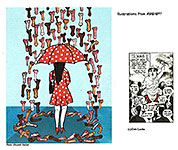
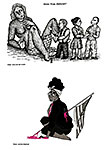
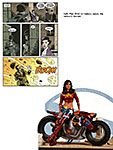
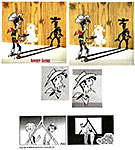
0.jpg)
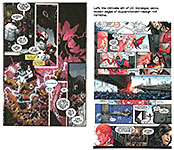
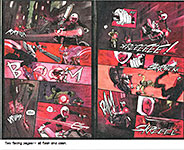
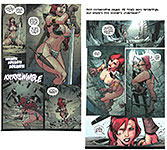
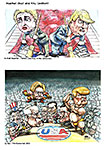



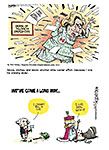
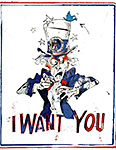
1.jpg)
2.jpg)
3.jpg)
4.jpg)
5.jpg)
6.jpg)
7.jpg)
8.jpg)
9.jpg)
10.jpg)
11.jpg)
12.jpg)
13.jpg)
1.jpg)
2.jpg)
3.jpg)
4.jpg)
5.jpg)
6.jpg)
7.jpg)
8.jpg)
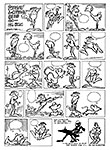
9.jpg)
10.jpg)
11.jpg)
12.jpg)
